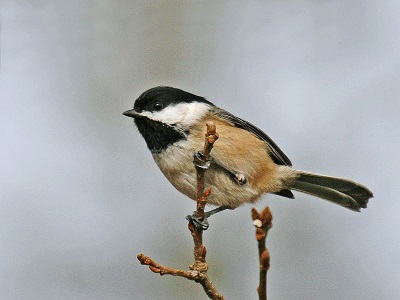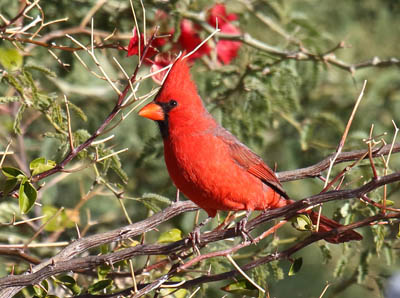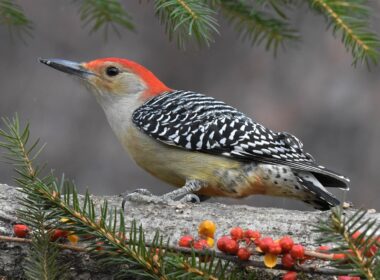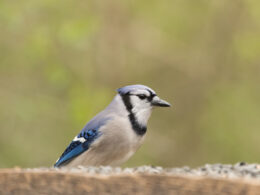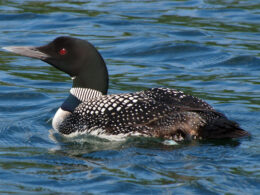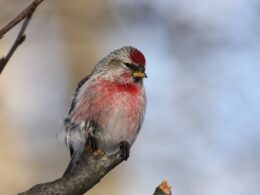Last Updated on January 24, 2024 by Greg Gillson
There are 17 species of wild finches native to North America and continental United States.
An additional 12 rare finches from Europe and Asia have been found a few times in North America.
A total of 29 different kinds of finches have been seen as wild birds in North America, north of Mexico.
Many finches are common backyard birds. They travel in large flocks throughout the year. They are some of the first birds to visit your feeder when you set it up. They often sit on your feeder eating, while other birds carry seeds away to eat them.
- What, exactly, is a finch?
- How are finches different from sparrows and wrens?
- What do finches look like?
- What do finches sound like?
- What kind of finches are in each state?
- Where is the best place in each state to find and view finches?
- How do you attract finches to your feeder?
- What other rare finches might you see in North America?
This article answers all these questions!
What is a finch?
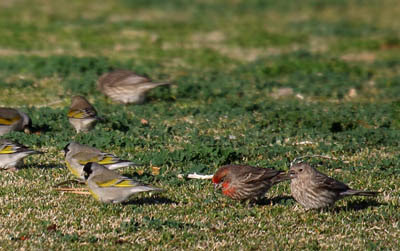 |
| House Finches and Lawrence’s Goldfinches. Greg Gillson. |
Finches are small colorful songbirds.
There are more than 250 species of true finches in the world.
Perhaps the best-known example of a finch is the domestic canary, a common cagebird. Domestic canaries originally came from the wild canaries on the Canary Islands, Azores, and Madeira off North Africa.
In the United States, House Finches are the most widespread and common finch in backyards and feeders. They are found in every major town in the continental United States.
Finches are found throughout most of the world, but not Australia or Antarctica.
As songbirds, finches have both simple calls and complex learned songs. Finches will sometimes mimic other birds and incorporate the songs of other bird species into their own song (source).
Grosbeaks and Rosy-Finches have less complicated songs than the goldfinches and red finches.
Male finches have red, orange, or yellow highlights to a base plumage of brown, gray, black, and white. Females are either duller or are streaked brown.
Finches have short, thick, pointed bills. Their bill shape is described as conical, or cone shaped. They are suitable for cracking open heavy seeds and nuts. Goldfinches have dainty versions of these bills with which they eat thistle seeds and other small seeds.
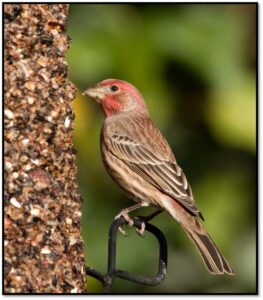
Finches do not nest in bird houses. They build their own nests out of sticks, usually high in trees. House Finches will build nests on three-sided platforms, wreaths on doors, on top of porch light fixtures, and many other places on buildings.
Scientific taxonomy is complex (and changes frequently). You don’t really need to know this information unless you are a biologist or ornithologist. Briefly, true finches are in the family Fringillidae. North American (north of Mexico) finches are all in the subfamily Carduelinae.
The 17 finches found regularly in the continental United States are divided into the following genera as follows:
- Hesperiphona: Evening Grosbeak
- Pinicola: Pine Grosbeak
- Leucosticte: Gray-crowned Rosy-Finch, Black Rosy-Finch, Brown-capped Rosy-Finch
- Haemorhous: House Finch, Purple Finch, Cassin’s Finch
- Acanthis: Common Redpoll, Hoary Redpoll
- Loxia: Red Crossbill, Cassia Crossbill, White-winged Crossbill
- Spinus: American Goldfinch, Lesser Goldfinch, Lawrence’s Goldfinch, Pine Siskin
Several rare finches have been recorded in North America. They are listed at the end of the species accounts for the regular finches.
I do not include the Hawaiian Honeycreepers and related birds that were recently included in the Finch family.
The word “finch” is older than the scientific classification method, so there are birds called finches that aren’t in the true finch (Fringillidae) family. There are some birds called finches in the families of estrildid finches, old world buntings, new world sparrows, and tanagers.
The differences between these can be confusing. Scientists use DNA to reveal similarities and assign birds to various families of birds. These relationships have changed several times and are likely to again.
So, Evening Grosbeaks and Pine Grosbeaks are in the Finch Family. But Rose-breasted Grosbeaks, Black-headed Grosbeaks, and Blue Grosbeaks are in the Cardinal Family along with some North American Tanagers. See? Confusing!
What is the difference between finches and sparrows?
Finches are easily confused with sparrows. Both are small to medium-sized songbirds with thick conical bills. Both may show up in your yard and feeders where they eat seeds.
There isn’t one thing that separates sparrows from finches. Instead, a combination of characters separates them.
These characters should help you identify finches.

In general, here are the differences between finches and sparrows. Compare the same numbers of the two lists that follow:
Finches
- Brightly colored males, dull females
- Most are not migratory
- Not territorial, defend female
- Feed nestlings seeds
- Most have notched or slightly forked tails
- Pointed wings
- Rounded head
- Often in large flocks throughout year
- Feed on seeds in trees
- Usually shorter gray legs
- When frightened usually fly up into treetops
Sparrows
- Males and females with similar subdued colors
- Many are migratory
- Territorial, defend land
- Feed nestlings insects
- Various tail shapes, round, square
- Most have rounded wings
- Many with flat heads
- Often solitary pairs; flock only in winter
- Feed on seeds and insects on ground
- Usually longer pink legs
- When frightened often dive into low cover
Here is the same information in table format:
| Finches | Sparrows |
|---|---|
| 1. Brightly colored males, dull females | 1. Males and females with similar subdued colors |
| 2. Most are not migratory | 2. Many are migratory |
| 3. Not territorial, defend female | 3. Territorial, defend land |
| 4. Feed nestlings seeds | 4. Feed nestlings insects |
| 5. Most have notched or slightly forked tails | 5. Various tail shapes, round, square |
| 6. Pointed wings | 6. Most have rounded wings |
| 7. Rounded head | 7. Many with flat heads |
| 8. Often in large flocks throughout year | 8. Often solitary pairs; flock only in winter |
| 9. Feed on seeds in trees | 9. Feed on seeds and insects on ground |
| 10. Usually shorter gray legs | 10. Usually longer pink legs |
| 11. When frightened usually fly up into treetops | 11. When frightened often dive into low cover |
Those are the typical differences between finches and sparrows. But it seems you can always find an exception.
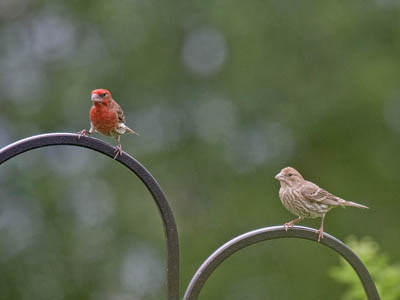 |
| Male and female House Finch. Greg Gillson. |
The photo above shows the bright red male House Finch and the plain brown striped female. This is typical for finches. Male and female finches are colored very differently. When males and females are different in size or color this is called sexual dimorphism.
On the other hand, it can be hard to tell male from female sparrows.
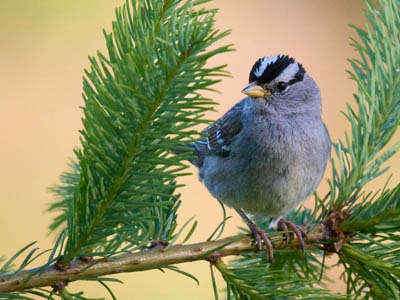 |
| White-crowned Sparrow. Greg Gillson. |
That is a beautiful White-crowned Sparrow in the photo above. But is it male or female? They look so similar, I can’t tell.
And for the exception? It is hard to tell apart male and female Pine Siskins. Some individuals are brighter, some more colorful, but not necessarily based on gender.
[At your feeder you are sure to see House Sparrows. Colored in brown, gray, and black, males and females are different. They are originally from Europe. They are in the Weaver family (or Weaver Finches), not the New World Sparrow family. They are not True Finches. More confusion.]
Finches typically do not migrate. However, northern finches will leave the boreal forests of Canada in winter if the conifer trees fail to produce a good crop of cone seeds. That happens every couple of years. Then, large flocks of northern finches (Pine Siskins, Evening Grosbeaks, crossbills) move south. This is called an irruption.
Red Crossbills roam around the country following the ripening pinecones (pine, fir, spruce, hemlock cones). They tend to breed any time of year when they find a good cone crop.
American Goldfinches, Purple Finches, Gray-crowned Rosy-Finches, and Pine Siskins have some parts of their population that moves north in summer and south in winter. But much of the main population in between remains in the same area year-round.
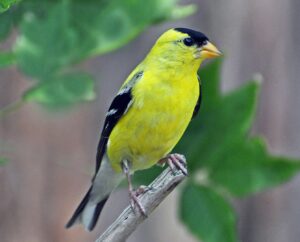
What is the difference between wrens and finches?
At least this is an easier question! Many beginners confuse finches and wrens.
Finches have short thick triangular bills for cracking seeds and nuts.
Wrens have long thin pointed bills to pry insects from furrows in the bark.
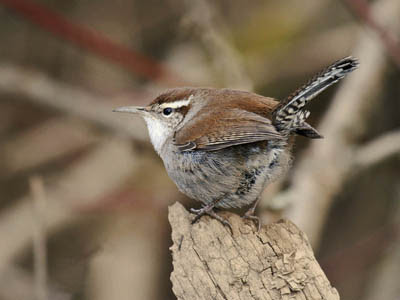 |
| Bewick’s Wren. Greg Gillson. |
Male finches are bright, females are dull, often looking quite different. Male and female wrens are very similar in coloration, in various browns and grays.
The tail of finches is rather short and in line with their back. The tail of wrens is usually long and flops around but is often held at a right angle to the back–straight up! The tail of wrens is often barred underneath with black-and-white.
Wrens are shy and solitary. They crawl around tangles and brush piles, close to the ground. Rarely they may come out in the open to eat at your suet feeder. When frightened they dive into dense low cover and hide.
Most finches travel in flocks. When frightened they fly up into treetops where they can keep an eye on you.
These differences will help you separate wrens from finches.
Identification and facts about finches of the United States (North American continent, north of Mexico)
Red Finches and crossbills
North American red finches were recently split or separated by taxonomists from the genus of European rosefinches, Carpodacus.
The 3 species of North American rosefinches are now in their own genus Haemorhous.
This change is due primarily to new research using DNA to ascertain genetic relationships.
It is quite difficult to identify these three finches and tell them apart from each other. But it is possible. Don’t give up!
For several years birders and scientists have been debating whether Red Crossbills should be split into at least 10 different species based on their call types.

It seems that crossbills are nomadic and don’t really stick to their territory as much as only stay with others of their call type. When crossbills of different call types mix together, they tend not to interbreed with crossbills that give other calls.
How would bird watching change if species such as these could only be identified by recordings and sonograms? (Seeing Bird Sounds on Donald Kroodsma’s website describes sonograms.)
The eBird has a primer on Red Crossbill call types.
House Finch (Haemorhous mexicanus)
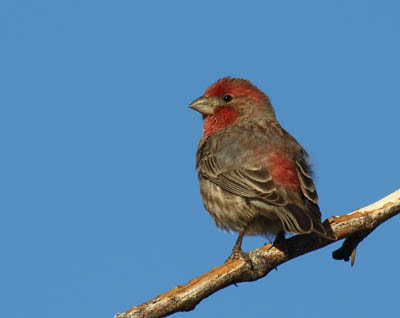 |
| Male House Finch. Greg Gillson. |
House Finches are the common resident species of red finch visiting feeders in towns throughout the United States, Mexico, and southernmost Canada.
In the United States, the red finches at your feeder are likely to be House Finches.
Identification: What do House Finches look like?
The key identification features of male House Finches are the heavy stripes on the underparts, and the red brightest on the forehead, chest, and rump.
 |
| Female House Finch. Greg Gillson. |
The key identification features of female House Finches are the unpatterned face and striped underparts.
 |
| Yellowish male House Finch. Greg Gillson. |
The red coloration on male House Finches is influenced by carotenoids in their diet. (source)
Often, the color of House Finches tends toward orange, or rarely yellow, as the bird in the photo above.
How do you attract House Finches to your feeder?
House Finches are very easy to attract to your yard and feeder. Attract House Finches with black oil sunflower seeds in a tube or hopper feeder. They prefer black oil sunflower seeds over sunflower seed kernels or striped sunflowers. They will eat fruit and Niger seed.
House Finches on eBird: Maps of actual sightings. Over 146,000 photos. Over 4200 recordings of House Finch calls and songs revealing what they really sound like. Over 175 videos of House Finches. (March 2022) These are on the Macaulay Library.
House Finches on All About Birds: An online field guide from TheCornellLab.
Purple Finch (Haemorhous purpureus)
 |
| Male Purple Finch. Greg Gillson. |
Purple Finches breed in summer in northern mixed and conifer forests, in the West and across Canada and in the Midwest and Northeastern States.
In winter birds in northern Canada move south and can be found throughout the East.
For many people, Purple Finches show up irregularly at feeders in winter and spring. Even where Purple Finches are resident, House Finches are usually more common at feeders in town.
Identification: What do Purple Finches look like?
Male Purple Finches are mottled below, not strongly streaked. The entire upper parts are washed with rose red, including all of the top of the head. The wide pink eye strip wraps around a dark ear covert.
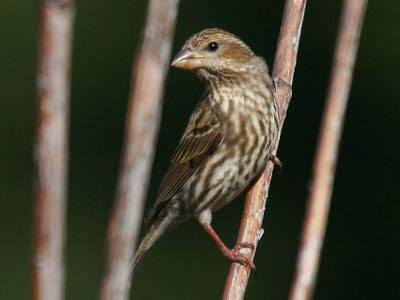 |
| Female Purple Finch. Greg Gillson. |
The female Purple Finch is heavily streaked below. However, females are identified by a definite dark ear covert surrounded by a pale eyebrow (supercilium) and pale submoustachial stripe. This is quite different than the unpatterned head of female House Finch.
Males often sing from the tops of the highest forest trees.
How do you attract Purple Finches to your feeder?
Purple Finches eat black oil sunflower seeds from tube or hopper feeders.
Purple Finches on eBird: Maps of actual sightings. Over 82,000 photos. Over 2600 recordings of Purple Finch calls and songs revealing what they really sound like. Over 100 videos of Purple Finches. (March (2022) These are on the Macaulay Library.
Purple Finches on All About Birds: An online field guide from TheCornellLab.
Cassin’s Finch (Haemorhous cassinii)
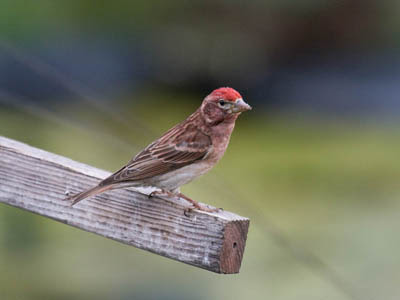 |
| Male Cassin’s Finch. Greg Gillson. |
Cassin’s Finches are found in mountains of the West. They breed from southern British Columbia to northern Arizona and New Mexico. Some birds move south in winter into mountains as far as central Mexico. They are found primarily in ponderosa and lodgepole pine forests, often into quaking aspen.
They are most similar to Purple Finches. However, Cassin’s Finches are found in dry mountain pine forests. Purple Finches are found in damper hemlock and fir forests and woods mixed with maples and other deciduous trees.
Identification: What do Cassin’s Finches look like?
Besides habitat, these birds are identified by several subtle differences from other red finches. These birds are shaped with a peaked crown. The bill is large with straight top and bottom edges (note the curved culmen of the smaller billed House Finch). The tail is sharply forked.
Males are dusted in delicate pale pink, brightest on the crown. The underparts lack streaks.
 |
| Female Cassin’s Finch. Greg Gillson. |
Female Cassin’s Finches are similar to female Purple Finches. They have a darker ear patch outlined with wide pale lines on eyebrow and cheek. Streaks below are sharp and thin compared to Purple Finch.
Cassin’s Finches come to feeders in those few towns within the ponderosa forest. Look for them at ski resorts and mountain forest campgrounds and recreation areas.
How do you attract Cassin’s Finches to your feeder?
If you live among ponderosa or lodgepole pines in the western mountains, you can attract these birds to your hopper feeder with black oil sunflower seeds.
Cassin’s Finch on eBird: Maps of actual sightings. Over 18,000 photos. Over 780 recordings of Cassin’s Finch calls and songs revealing what they really sound like. Over 40 videos of Cassin’s Finches. (March 2022) These are on the Macaulay Library.
Cassin’s Finches on All About Birds: An online field guide from TheCornellLab.
Red Crossbill (Loxia curvirostra)
 |
| Male Red Crossbill. Greg Gillson. |
Crossbills are found in all types of cone-bearing conifers. However, they are nomadic and follow the ripening cone seed crops. They are usually present in forests from southern Alaska and across Canada, south in mountains of the West through Mexico.
In winter, during poor local cone crops, Red Crossbills may “irrupt” southward through much of the Unites States seeking other conifer cone seeds.
Identification: What do Red Crossbills look like?
Males are identified by their dull reddish bodies throughout, with dark wings and tail. They have crossed bills, obvious at close range.
Red Crossbills have variation in the size of their bills. Large-billed populations generally feed on large pine cones. Smaller billed populations feed on smaller spruce and hemlock cone seeds.
 |
| Red Crossbills. Greg Gillson. |
Females are colored dull yellowish, but they have the typical big head, plump body, and short forked tail.
As mentioned above, there are at least 10 different call types. Each call type corresponds to a population with similar bill size.
Crossbills are usually seen in flocks, sometimes of 100 or more birds, seen flying at tree-top level through the forest. They do descend to the ground on some occasions. The sometimes visit cold fire pits in forest campgrounds.
Because they rely on cone crops, they may breed at any time of year when there is a good crop of cone seeds.
How do you attract Red Crossbills to your feeder?
Red Crossbills generally feed on cones high in the treetops. Thus, they don’t usually visit bird feeders so close to the ground. Red Crossbills may visit your birdbath. They may also visit the ground for road salt or gravel.
Red Crossbills on eBird: Maps of actual sightings. Over 48,000 photos. Over 14,000 recordings of Red Crossbill calls and songs revealing what they really sound like. Over 230 videos of Red Crossbills. (April 2022) These are on the Macaulay Library.
Red Crossbills on All About Birds: An online field guide from TheCornellLab.
Cassia Crossbill (Loxia sinesciuris)
These crossbills are found in lodgepole pine forests of South Hills and Albion Mountains in southern Idaho.
Identification: What do Cassia Crossbills look like?
Males are red and females are yellow, as other crossbills. Identification: Cassia Crossbills are only told from other crossbills by call notes.
These crossbills apparently do not leave this tiny area in Cassia County, Idaho.
They were recently discovered and named. So, you may not find them in your field guides.
How do you attract Cassia Crossbills to your feeder?
First, you have to live among the lodgepole pines high in the mountains of Cassia County, Idaho. Only there. Even then, both Red Crossbills and Cassia Crossbills occur. Crossbills are more likely to visit your bird bath than feeder.
Cassia Crossbill on eBird: Maps of actual sightings. Over 780 photos. Over 220 recordings of Cassia Crossbill calls and songs revealing what they really sound like. (No videos, yet) of Cassia Crossbill. (April 2022) These are on the Macaulay Library.
Cassia Crossbill on All About Birds: An online field guide from TheCornellLab.
White-winged Crossbill (Loxia leucoptera)
 |
| White-winged Crossbill. CC0. |
White-winged Crossbills are found in boreal forests across Alaska and Canada, south barely into the northern tier of states in the Northeast, Midwest, and West. They especially like spruce and larch (tamarack) trees.
During winters of poor cone production in the north, they may “irrupt” southward into the northern half of the United States.
Identification: What do White-winged Crossbills look like?
Male White-winged Crossbills are identified by their pink coloration and broad white wing bars on their black wings.
Females are streaked with greenish yellow coloration. They show a white wing patch similar to the male.
Male White-winged Crossbills have rather pink plumage on fresh feathers in the fall. By summer the pale feather tips have worn off. Then the plumage appears darker red.
How do you attract White-winged Crossbills to your feeder?
Only an out-of-place White-winged Crossbill is likely ever to visit a bird feeder. They primarily feed on spruce seeds in northern and high-elevation forests.
White-winged Crossbill on eBird: Maps of actual sightings. Over 26,500 photos. Over 1300 recordings of White-winged Crossbill calls and songs revealing what they really sound like. Over 100 videos of White-winged Crossbills. (April 2022) These are on the Macaulay Library.
White-winged Crossbills on All About Birds: An online field guide from TheCornellLab.
Goldfinches, siskins, and redpolls
These are tiny birds. Lesser Goldfinches are the smallest, some individuals only 3-1/2 inches, bill to tail. The larger redpolls and siskins may be 5-1/2 inches long. That’s still tiny!
Goldfinches and siskins have obvious yellow in their plumage.
Redpolls are named for the red top of the head. Some birds may appear pinkish, but often they are quite pale or whitish.
Not all yellow birds are finches. Here’s a related article:
What birds are yellow and black?
American Goldfinch (Spinus tristis)
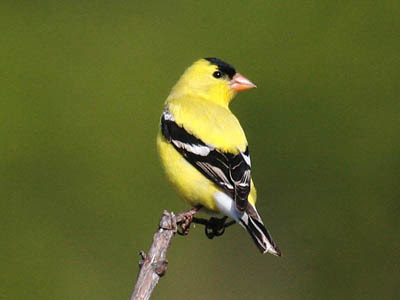 |
| Breeding male American Goldfinch. Greg Gillson. |
American Goldfinches are found in scrubby grassland habitats. Overgrown pastures with patches of deciduous trees and thistles are a favorite habitat. They are also found in parks and residential backyards.
They are resident across the northern half of the United States and the West Coast.
In summer part of the population moves into Canada and the northern Plains States of the US. They then migrate south in winter so that American Goldfinches are found in winter to all the southern States and northern and eastern Mexico.
American Goldfinches are unusual as finches in that they molt twice a year. They have a separate breeding and non-breeding plumage. Other finches typically molt in the fall and don’t change appearance, other than getting a fresh set of feathers.
Identification: What do American Goldfinches look like?
Adult males, from April to September are identified by the bright yellow body. They have a black forecrown. The wings and tail are black with white edges.
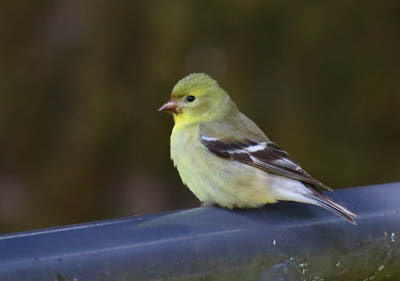 |
| Female American Goldfinch. Greg Gillson. |
Females are rather dull year-round. In addition, male American Goldfinches from late September to March look quite similar to the bird above.
They are rather gray or brownish, with yellow on the head. The dark gray wings have obvious white wing bars. The key identification mark for separating female and non-breeding male American Goldfinches from Lesser Goldfinches is the white under tail coverts.
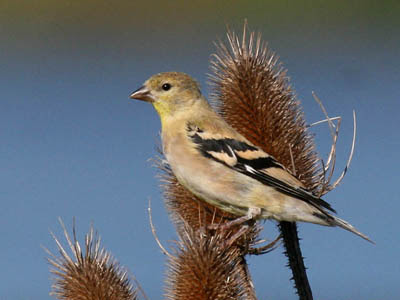 |
| Juvenile American Goldfinch. Greg Gillson. |
American Goldfinches lay 2-7 eggs and nest once or twice per season.
In late fall you will find flocks of hundreds of American Goldfinches in weedy fields and road edges. Most of these will be immature birds as pictured above. Young birds keep this plumage until their first spring, March or April.
Juveniles are a pale clay-brown color. They have a hint of yellow on the throat. Wings are black with wide tan wing bars.
How do you attract American Goldfinches to your feeder?
American Goldfinches are attracted to black oil sunflower seeds and Niger seed. They prefer a tube feeder (sometimes also called a finch feeder) which limits some of the other more aggressive species. However, they may also feed under the feeder on small seeds knocked out of the feeder by other birds. They love Niger seeds from thistle socks or metal mesh feeders. They also frequent bird baths.
American Goldfinch on eBird: Maps of actual sightings. Over 130,000 photos. Over 3500 recordings of American Goldfinch calls and songs revealing what they really sound like. Over 225 videos of American Goldfinches. (April 2022) These are on the Macaulay Library.
American Goldfinches on All About Birds: An online field guide from TheCornellLab.
Lesser Goldfinch (Spinus psaltria)
 |
| Male Lesser Goldfinch. Greg Gillson. |
If you see a bright yellow goldfinch in the winter in the West, it is a Lesser Goldfinch. Unlike American Goldfinches, Lesser Goldfinches keep their bright plumage all year.
They are found in drier habitats, chaparral, oak woodlands, and residential backyards.
They are year-round residents from southwestern Washington State south through California and east across Arizona to Texas and south into northern South America. In summer part of the population moves into the Great Basin–from eastern Oregon to Colorado.
Identification: What do Lesser Goldfinches look like?
Male Lesser Goldfinches are identified by their bright yellow under parts, black cap, black wings and tail with white bars and edges. The back may be green or black, depending upon location. Birds in Texas usually have black backs. Birds in California have green backs. Populations south of central Mexico also have black backs.
 |
| Female/Immature Lesser Goldfinch. Greg Gillson. |
The photo above is an example of a very dull individual. Most females are quite yellow and yellow-green throughout, with darker wings and white wing bars.
One identification help is that the under tail coverts of Lesser Goldfinches are yellow, while they are white on American Goldfinches.
Lesser Goldfinches often include songs of other birds in their song.
How do you attract Lesser Goldfinches to your feeder?
Lesser Goldfinches are especially attracted to Niger seed in thistle socks or metal mesh finch feeders. They also love black oil sunflower seeds in tube feeders. They come to bird baths. If it’s been a while since you mowed the lawn, you may find Lesser Goldfinches feeding on dandelions or other weeds that have gone to seed.
Lesser Goldfinch on eBird: Maps of actual sightings. Over 58,000 photos. Over 1400 recordings of Lesser Goldfinch calls and songs revealing what they really sound like. Over 100 videos of Lesser Goldfinches. (April 2022) These are on the Macaulay Library.
Lesser Goldfinches on All About Birds: An online field guide from TheCornellLab.
Lawrence’s Goldfinch (Spinus lawrencei)
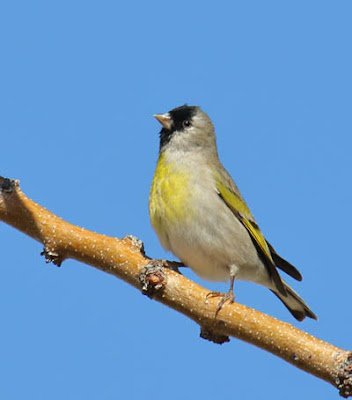 |
| Male Lawrence’s Goldfinch. Greg Gillson. |
Lawrence’s Goldfinches are birds of chaparral and oaks, often near water. In summer they breed in California and Baja California. In winter they are found in southern California and across southern Arizona, southwestern New Mexico, and northwestern Mexico.
These birds are rather nomadic. They may breed in one location one year and be absent the next. They often follow the flowering of fiddleneck plants (Amsinckia).
Identification: What do Lesser Goldfinches look like?
Males are gray with yellow breast. They have a black face. Wings are dark with broad yellow patches and edges.
 |
| Female Lawrence’s Goldfinch. Greg Gillson. |
Females are gray with yellow wing edges.
Lawrence’s Goldfinches are found in flocks in winter. Even in summer, pairs seem to be near others.
How do you attract Lawrence’s Goldfinches to your feeder?
Lawrence’s Goldfinches live in open oak woodlands and chaparral primarily in California, and then Arizona in winter. A bird bath may be the best way to attract them in these areas. They will eat small weed seeds in your abandoned garden in winter.
Lawrence’s Goldfinch on eBird: Maps of actual sightings. Over 13,300 photos. Over 300 recordings of Lawrence’s Goldfinch calls and songs revealing what they really sound like. Over 35 videos of Lawrence’s Goldfinches. (April 2022) These are on the Macaulay Library.
Lawrence’s Goldfinches on All About Birds: An online field guide from TheCornellLab.
Pine Siskin (Spinus pinus)
 |
| Pine Siskin. Tube feeder. Greg Gillson. |
These birds are found in conifer forests with small cones, such as hemlock, larch, spruce. They also like the seeds of alder, birch, and maple trees.
Pine Siskins breed across Canada and southern Alaska south in the West in mountains of central Mexico. In winter they retreat from the north and irregularly may be found across all of the United States, though very rare along the Gulf Coast.
These birds are usually found in large flocks. They often join in flocks of other goldfinches.
Identification: What do Pine Siksins look like?
Siskins are small. and streaked with brown. They show yellow in the wings and tail, most obvious in flight.
 |
| Pine Siskins. Birdbath. Greg Gillson. |
Genders are similar in coloration. Some individuals may be yellower or greener. Some birds are sharply streaked with darker brown; others show less contrast and wider paler streaks.
They have winter irruptions, sometimes far south, in response to the failure of cone production in the north.
How do you attract Pine Siskins to your feeder?
Pine Siskins love Niger seed from thistle feeders or wire mesh finch feeders. They also like black oil sunflower seeds from tube or hopper feeders.
Pine Siskin on eBird: Maps of actual sightings. Over 87,000 photos. Over 2500 recordings of Pine Siskin calls and songs revealing what they really sound like. Over 100 videos of Pine Siskins. (April 2022) These are on the Macaulay Library.
Pine Siskin on All About Birds: An online field guide from TheCornellLab.
Common Redpoll (Acanthis Flammea)
 |
| Common Redpoll. Greg Gillson. |
Found in Arctic tundra, birch, and boreal forests. They breed from Alaska, across northern Canada to Greenland. In winter they migrate to southern Canada and barely into the northern United States in most winters. They occasionally irrupt south to mid-latitudes of the US.
Common Redpolls are abundant and one of the birds that nests the farthest north (Snow Bunting probably has the distinction of northernmost breeder in the bird world).
Identification: What do Common Redpolls look like?
These are small birds with small round heads. The tail is short and forked. Males have a black chin and face. They have a red cap on the front of the head. Underparts are white but streaked lightly and also show a pinkish wash across the breast. They have two white wing bars.
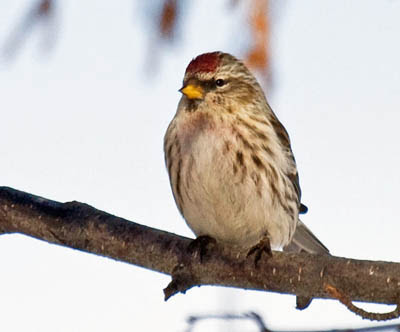 |
| Common Redpoll. Greg Gillson. |
Females are similar to males but a bit more buffy on the chest (lacking red chest) and are more heavily streaked below.
Look for flocks of these birds swirling around birch tree catkins in the snow.
How do you attract Common Redpolls to your feeder?
Attract this bird to your yard with birch trees. They will visit feeders to eat Niger seed from metal mesh finch feeders. They also eat black oil sunflower seeds from tube or hopper feeders.
Common Redpoll on eBird: Maps of actual sightings. Over 70,000 photos. Over 1100 recordings of Common Redpoll calls and songs revealing what they really sound like. Over 150 videos of Common Redpolls. (April 2022) These are on the Macaulay Library.
Common Redpoll on All About Birds: An online field guide from TheCornellLab.
Hoary Redpoll (Acanthis hornemanni)
There has been a debate among ornithologists for the past several years of whether the Hoary Redpoll is a distinct species. Many feel it is only a pale Common Redpoll.
It isn’t an easy problem to resolve, as they breed in remote Arctic tundra. Until there is a scientific study across their breeding grounds, this puzzle won’t be solved.
Identification: What do Hoary Redpolls look like?
Hoary Redpolls are very white below, lacking the streaking on sides of the Common Redpoll. But there is quite a range of variation between the two. Only extreme pale birds are definitely identifiable (for now).
How do you attract Hoary Redpolls to your feeder?
These northern birds only rarely visit feeders with other redpolls. They will eat Niger seed and black oil sunflower seeds.
Hoary Redpoll on eBird: Maps of actual sightings. Over 15,000 photos. Over 65 recordings of Hoary Redpoll calls and songs revealing what they really sound like. Over 50 videos of Hoary Redpolls. (April 2022) These are on the Macaulay Library.
Hoary Redpolls on All About Birds: An online field guide from TheCornellLab.
Grosbeaks
Not all grosbeaks are in the Finch family (Fringillidae). In fact, in the United States only two grosbeaks are finches: Evening Grosbeaks and Pine Grosbeaks.
Most grosbeaks in North America are in the Cardinal family (Cardinalidae). You may know some of these such as Rose-breasted Grosbeak, Black-headed Grosbeak, and Blue Grosbeak.
What’s the difference between grosbeaks in the Finch family and grosbeaks in the Cardinal family? Primarily the differences are in the DNA.
Evening Grosbeak (Coccothraustes vespertinus)
 |
| Male Evening Grosbeak. Greg Gillson. |
Evening Grosbeaks are birds of the northern conifer forests.
They breed and live year-round across mid and southern Canada and barely into the northern tier of states in the US, from Maine to Minnesota. They also breed commonly in mountains of the West, south to northern California and northern Utah. They are scarce breeders from Colorado, Arizona, New Mexico, south into Mexico.
They winter in their breeding areas, but irregularly irrupt southward. They regularly reach across the northern United States in winter, but occasionally across all but the immediate Gulf Coast and Southeast coastal area.
Their diet is mostly seeds of conifer trees. They love black oil sunflower seeds at feeders at homes in conifer forests. They also eat the buds of maple trees in spring.
Identification: What do Evening Grosbeaks look like?
Males are yellow, black, and white. The dusky brown head has a bold yellow eyebrow stripe. They show a large patch of white on the wing. This large white trailing patch on the wing also shows as they fly overhead.
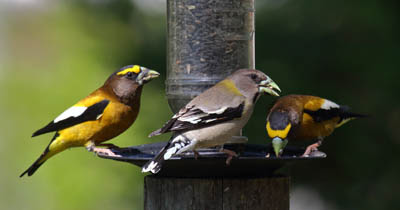 |
| Evening Grosbeaks. Hopper feeder. Greg Gillson. |
Females are gray with a bit of yellow on the back of the neck. The wings and tail are black with white edges. The bill is a pale blue-green color.
Even though Evening Grosbeaks are classified well within the songbirds, they actually don’t have a learned song. They do have simple descending whistled call notes. There are 5 populations of Evening Grosbeaks, each with unique calls. See Evening Grosbeak Call Types on eBird, for more information.
How do you attract Evening Grosbeaks to your feeder?
Evening Grosbeaks love black oil sunflower seeds. And flocks can consume a lot of seed in a short time! Feed from a hopper or platform feeder.
Evening Grosbeak on eBird: Maps of actual sightings. Over 52,000 photos. Over 2900 recordings of Evening Grosbeak calls and songs revealing what they really sound like. Over 100 videos of Evening Grosbeaks. (April 2022) These are on the Macaulay Library.
Evening Grosbeak on All About Birds: An online field guide from TheCornellLab.
Pine Grosbeak (Pinicola enucleator)
 |
| Immature male Pine Grosbeak. Greg Gillson. |
These birds are found in boreal and high mountain forests.
They are found year-round across eastern and northern Canada, Alaska, and the Rocky Mountains from British Columbia to Wyoming. Then they are found in isolated high mountains south to California, Arizona, and New Mexico.
In some winters birds move to southern Canada, the Midwest, and the Northeast. Here they seek out crabapples and mountain ash.
In the West, these birds breed in mountains most commonly from 6000 to 9000 feet elevation.
Identification: What do Pine Grosbeaks look like?
These are fairly large finches. They are almost the size of American Robins. Breeding males are red or pink and gray. They have white wing bars. Immature males have an orange wash on the head and rump.
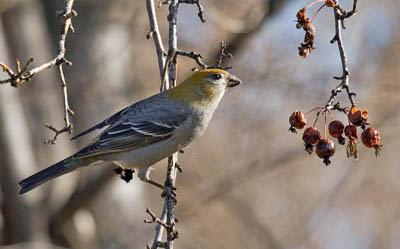 |
| Female Pine Grosbeak. Greg Gillson. |
Female Pine Grosbeaks are gray with yellow head. They have two white wing bars.
Birds form flocks in winter. They are often described as sluggish and tame, feeding in trees often quite close to people without flying away.
How do you attract Pine Grosbeaks to your feeder?
Attract Pine Grosbeaks to your feeder with black oil sunflower seeds using any type of seed feeder. They will also eat suet from a suet feeder.
Pine Grosbeak on eBird: Maps of actual sightings. Over 37000 photos. Over 900 recordings of Pine Grosbeak calls and songs revealing what they really sound like. Over 90 videos of Pine Grosbeaks. (April 2022) These are on the Macaulay Library.
Pine Grosbeaks on All About Birds: An online field guide from TheCornellLab.
Rosy-Finches
Rosy-Finches are rather unique among the finches in North America. They nest on rocky cliffs on highest mountains, above the treeline, amid snowfields and talus slopes.
In winter they often descend to lower elevations and form huge flocks in fields and rural towns.
Four species of Rosy-Finches were combined (“lumped”) into one species in 1983. But they were later re-separated after extensive research.
Gray-crowned Rosy-Finch (Leucosticte tephrocotis)
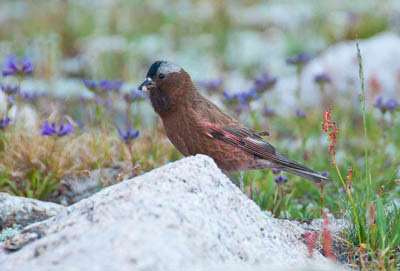 |
| Gray-crowned Rosy-Finch. Public Domain. |
They are found on rocky slopes and edges of glaciers on high mountains. Also, some islands in Alaska.
Residents on Aleutian Islands, otherwise year-round residents at edge of glaciers on high mountains from southern British Columbia to northern California. In summer birds breed across Alaska south through British Columbia. But these birds move south and descend to lower elevations in winter. They winter in flocks from the Canadian border south from northeastern California to northern New Mexico.
Identification: What do Gray-crowned Rosy-Finches look like?
Genders are colored similarly. They are warm brown with gray on the head. Some populations have an extensive gray head with black forehead and chin. The wing, tail, and belly feathers are tipped with delicate pink.
These birds tend to be fearless.
How do you attract Gray-crowned Rosy-Finches to your feeder?
If you live in a ski-resort or similar high-elevation community, you can attract Gray-crowned Rosy-Finches by throwing black oil sunflower seed on bare ground or feeding from a platform feeder.
Gray-crowned Rosy-Finch on eBird: Maps of actual sightings. Over 11,000 photos. Over 125 recordings of Gray-crowned Rosy-Finch calls and songs revealing what they really sound like. Over 60 videos of Gray-crowned Rosy-Finches. (April 2022) These are on the Macaulay Library.
Gray-crowned Rosy-Finches on All About Birds: An online field guide from TheCornellLab.
Black Rosy-Finch (Leucosticte atrata)
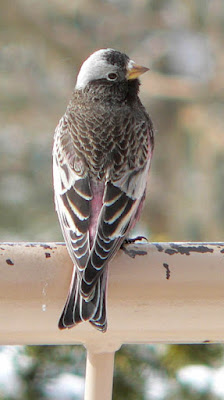 |
| Black Rosy-Finch. Public Domain. |
They are found on rocky mountaintops at the edge of glaciers, or even feeding on insects that fall onto the ice.
They breed above treeline on scattered high mountains within the Great Basin: Idaho, Montana, Wyoming, southeastern Oregon, northern Nevada, northern Utah. In winter they descend to nearby areas with bare ground, from southern Montana and southern Idaho to northeastern California to Colorado, barely into northern Arizona and northern New Mexico.
In winter you may find flocks on roadsides or near livestock feeding areas. They do visit feeders.
Identification: What do Black Rosy-Finches look like?
Genders are colored similarly. They are very dark brown, almost black, with gray on the back of the head. Wings and belly are pink.
How do you attract Black Rosy-Finches to your feeder?
Attract Black Rosy-Finches to feeders in high-elevation communities with black oil sunflower seeds or Niger seeds on platform feeders or bare ground.
Black Rosy-Finches on eBird: Maps of actual sightings. Over 4500 photos. Over 40 recordings of Black Rosy-Finch calls and songs revealing what they really sound like. Over 30 videos of Black Rosy-Finches. (April 2022) These are on the Macaulay Library.
Black Rosy-Finches on All About Birds: An online field guide from TheCornellLab.
Brown-capped Rosy-Finch (Leucosticte australis)
These birds breed in high mountains on the edge of glaciers and snowfields. They descend into nearby pastures and snow-free plains in winter. They are found only in Colorado and extreme northern New Mexico.
Identification: What do Brown-capped Rosy-Finches look like?
Genders are similar. They are light brown, including the head. The wings and lower belly are tinged with pink.
Their restricted mountaintop breeding range and low numbers mean that these are an endangered species.
Like other rosy-finches, they feed on the ground or even on glaciers for wind-blown seeds and insects.
How do you attract Brown-capped Rosy-Finches to your feeder?
In high-elevation communities in Colorado in winter you may attract Brown-capped Rosy-Finches to your feeder. They eat mixed seeds including white proso millet, black oil sunflower seed, and Niger seed from platform feeders or on the bare ground.
Brown-capped Rosy-Finch on eBird: Maps of actual sightings. Over 3,000 photos. Over 45 recordings of Brown-capped Rosy-Finch calls and songs revealing what they really sound like. Over 9 videos of Brown-capped Rosy-Finches. (April 2022) These are on the Macaulay Library.
Brown-capped Rosy-Finches on All About Birds: An online field guide from TheCornellLab.
Rare Finches in North America
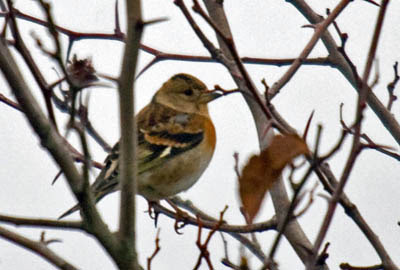 |
| Rare Brambling in Oregon in 2011. Greg Gillson. |
There are several other finches from Europe and Asia that sometimes appear as rarities in North America. Zealous bird watchers often go to the islands off Alaska, like Attu, to search for such out-of-place birds.
But sometimes such finches as these, and others not on this list, are presumed to be escaped cagebirds.
These are birds where at least some records of birds in the United States are thought to be of wild birds (link to page on eBird):
Common Chaffinch (Fringilla coelebs) Found in Europe.
Brambling (Fringilla montifringilla) Found in Europe and Asia.
Hawfinch (Coccothraustes coccothraustes) Found in Europe and Asia.
Common Rosefinch (Carpodacus erythrinus) Found in Europe and Asia.
Pallas’s Rosefinch (Carpodacus roseus) Found in Asia.
Eurasian Bullfinch (Pyrrhula pyrrhula) Found in Europe and Asia.
Asian Rosy-Finch (Leucosticte arctoa) Found in Asia.
European Greenfinch (Chloris cloris) Found in Eurasia; introduced into Australia, New Zealand, South America.
Oriental Greenfinch (Chloris sinica) Found in Asia.
Yellow-fronted Canary (Crithagra mozambica) Found in Africa; introduced Hawaii, Puerto Rico.
European Goldfinch (Carduelis carduelis) Found in Eurasia; introduced Australia, New Zealand, South America.
Eurasian Siskin (Spinus spinus) Found in Europe and Asia.
Please read the next section to find out if any of these rare birds have been reported in your state!
Finches of Every State and Where to Find and View Them
(Continental United States, excluding Hawaii)
Key to abundance terms
Common: Expected in good numbers; usually require little effort to find.
Uncommon: Expected regularly; may take extra searching to find.
Rare: Expected annually, usually in low numbers; an observer may have to search diligently in correct habitat to find.
Very Rare: Not expected annually, but usually several times per decade; may require several years of diligent search in the correct habitat to find.
Vagrant: Turns up unpredictably; unexpected, averaging well less than once per decade.
Alabama
What finches are in Alabama?
There are 9 types of finches in Alabama. Of these, 4 species are expected regularly and easy to find with little effort. Two species are very rare and require extra effort to find. Three species are vagrants and not expected with any regularity.
Where are the best public places to find and view finches in Alabama (eBird Hotspots)?
Following is a list of the finches of Alabama, their abundance and seasonal status, and a location or two where you can reliably find them.
Evening Grosbeak (very rare in winter, no reliable location)
House Finch (common year-round, widespread, Avondale Park)
Purple Finch (uncommon in winter, Palmore Park Swamp, Moss Rock Preserve)
Common Redpoll (vagrant)
Red Crossbill (very rare year-round, Talladega NF)
White-winged Crossbill (vagrant)
Pine Siskin (uncommon in winter, Moss Rock Preserve, Talladega NF)
Lesser Goldfinch (vagrant)
American Goldfinch (common year-round, widespread, Guntersville Dam)
Red, Orange, & Yellow Birds of Alabama
Alaska
What finches are in Alaska?
There are 20 types of finches in Alaska. Of these, 7 species are expected regularly and easy to find with little effort. 5 species are very rare and require extra effort to find. 8 species are vagrants and not expected with any regularity.
Where are the best public places to find and view finches in Alaska (eBird Hotspots)?
Following is a list of the finches of Alaska, their abundance and seasonal status, and a location or two where you can reliably find them.
Brambling (very rare fall to winter, Saint Paul Island)
Evening Grosbeak (very rare fall to spring, Ketchikan (town))
Hawfinch (vagrant)
Common Rosefinch (vagrant)
Pallas’s Rosefinch (vagrant)
Pine Grosbeak (uncommon winter, rare spring through fall, Sitka (town), Kincaid Park)
Eurasian Bullfinch (vagrant)
Asian Rosy-Finch (vagrant)
Gray-crowned Rosy-Finch (rare year-round, Homer Spit—Lands End)
House Finch (very rare summer, Ketchikan (town))
Purple Finch (very rare year-round, Ketchikan (town), Sitka (town))
Cassin’s Finch (very rare late winter and spring, no reliable location)
Oriental Greenfinch (vagrant)
Common Redpoll (uncommon year-round, widespread, Government Hill)
Hoary Redpoll (rare year-round, Westchester Lagoon)
Red Crossbill (rare year-round, Kodiak Is.–Fort Abercrombie State Historical Park)
White-winged Crossbill (uncommon winter and spring, rare summer and fall, widespread, Spenard Crossing)
Eurasian Siskin (vagrant)
Pine Siskin (uncommon year-round, widespread, Spenard Crossing, Ketchikan Airport Perimeter (Gravina Island))
American Goldfinch (vagrant)
Arizona
What finches are in Arizona?
There are 15 types of finches in Arizona. Of these, 8 species are expected regularly and easy to find with little effort. 3 species are very rare and require extra effort to find. 4 species are vagrants and not expected with any regularity.
Where are the best public places to find and view finches in Arizona (eBird Hotspots)?
Following is a list of the finches of Arizona, their abundance and seasonal status, and a location or two where you can reliably find them.
Evening Grosbeak (rare spring and fall, very rare summer and winter, Kachina Village–Pumphouse Wash Trail, Jacob Lake Campground)
Pine Grosbeak (vagrant)
Gray-crowned Rosy-Finch (very rare winter, no reliable location)
Black Rosy-Finch (very rare winter, no reliable location)
House Finch (common year-round, widespread, Desert Botanical Garden, Reid Park)
Purple Finch (very rare winter, Madera Canyon–Mt. Wrightson Picnic Area)
Cassin’s Finch (rare fall to spring, Grand Canyon NP–Visitor Center)
Common Redpoll (vagrant)
Red Crossbill (uncommon summer, rare fall through spring, Jacob Lake Campground, Sunrise Campground)
White-winged Crossbill (vagrant)
European Goldfinch (vagrant)
Pine Siskin (uncommon fall through spring, Cataract Lake, Grand Canyon NP–Widforss Trail)
Lesser Goldfinch (common year-round, widespread, Hassayampa River Preserve)
Lawrence’s Goldfinch (rare fall through winter, Hassayampa River Preserve, Isabella Lee Natural Preserve)
American Goldfinch (rare fall through spring, Dead Horse Ranch SP)
Red, Orange, and Yellow Birds of Arizona
Arkansas
What finches are in Arkansas?
There are 12 types of finches in Arkansas. Of these, 4 species are expected regularly and easy to find with little effort. 3 species are very rare and require extra effort to find. 5 species are vagrants and not expected with any regularity.
Where are the best public places to find and view finches in Arkansas (eBird Hotspots)?
Following is a list of the finches of Arkansas, their abundance and seasonal status, and a location or two where you can reliably find them.
Brambling (vagrant)
Evening Grosbeak (very rare winter through spring, no reliable location)
Pine Grosbeak (vagrant)
Gray-crowned Rosy-Finch (vagrant)
House Finch (common year-round, widespread, Two Rivers Park)
Purple Finch (uncommon winter and spring, Two Rivers Park, Wilson Springs Preserve)
Common Redpoll (very rare winter, no reliable location)
Red Crossbill (very rare all year, Ozark NF–Falling Water, Hobbs SP-CA–Visitor Center)
White-winged Crossbill (vagrant)
Pine Siskin (uncommon fall through spring, Allsopp Park, John A. and Mildred B. Cooper Nature Preserve)
Lesser Goldfinch (vagrant)
American Goldfinch (common all year, widespread, Hobbs SP-CA–Visitor Center)
Red, Orange, and Yellow Birds of Arkansas
California
What finches are in California?
There are 20 types of finches in California. Of these, 9 species are expected regularly and easy to find with little effort. 3 species are very rare and require extra effort to find. 8 species are vagrants and not expected with any regularity.
Where are the best public places to find and view finches in California (eBird Hotspots)?
Following is a list of the finches of California, their abundance and seasonal status, and a location or two where you can reliably find them.
Brambling (vagrant)
Evening Grosbeak (rare spring and summer, Shastice Park, Yosemite Falls–Headquarters area)
Hawfinch (vagrant)
Common Rosefinch (vagrant)
Pine Grosbeak (very rare year-round, Page Meadows, Tamarack Sno-Park)
Gray-crowned Rosy-Finch (very rare year-round, Aspendell, Carson Pass)
Black Rosy-Finch (vagrant)
House Finch (common year-round, widespread, Griffith Park–Old Zoo trails)
Purple Finch (uncommon year-round, Southern Humboldt Community Park, McGill Campground)
Cassin’s Finch (uncommon spring through fall, Iris Meadow, Lassen Volcanic NP–Manzanita Lake)
Oriental Greenfinch (vagrant)
Yellow-fronted Canary (vagrant)
Common Redpoll (vagrant)
Red Crossbill (rare year-round, Lassen Volcanic NP–Butte Lake, Van Damme SP–Visitor Center)
White-winged Crossbill (vagrant)
European Goldfinch (very rare year-round, Rio Hondo–Rush St. to Rosemead Blvd.)
Pine Siskin (uncommon winter, rare spring through fall, widespread, Hiller Park and Mad River Bluffs)
Lesser Goldfinch (common year-round, widespread, Audubon Bobcat Ranch)
Lawrence’s Goldfinch (rare spring and summer, very rare fall and winter, Lake Piru, Cibbets Flat Campground)
American Goldfinch (uncommon year-round, widespread, Sacramento NWR–Auto Route & Visitor Center)
Red, Orange, and Yellow Birds of California
Colorado
What finches are in Colorada?
There are 16 types of finches in Colorado. Of these, 12 species are expected regularly and easy to find with little effort. 3 species are very rare and require extra effort to find. 1 species are vagrants and not expected with any regularity.
Where are the best public places to find and view finches in Colorado (eBird Hotspots)?
Following is a list of the finches of Colorado, their abundance and seasonal status, and a location or two where you can reliably find them.
Brambling (vagrant)
Evening Grosbeak (uncommon year-round, Billy Creek SWA, Chatfield SP)
Pine Grosbeak (rare year-round, State Forest SP–Moose Visitor Center, Grand Mesa–Visitor Center)
Gray-crowned Rosy-Finch (uncommon winter and spring, Wapiti Wildlife Center, Wildernest (community))
Black Rosy-Finch (rare winter and spring, Wapiti Wildlife Center, Wildernest (community))
Brown-capped Rosy-Finch (rare year-round, Wapiti Wildlife Center, Wildernest (community))
House Finch (common year-round, widespread, Harriman Lake Park)
Purple Finch (very rare winter and spring, South Republican SWA)
Cassin’s Finch (uncommon year-round, widespread, State Forest SP–Moose Visitor Center)
Common Redpoll (rare in winter, very rare in spring, Lake Estes, Baseline Reservoir)
Red Crossbill (rare year-round, Black Canyon of the Gunnison NP–South Rim, Genesee Mountain Park)
White-winged Crossbill (very rare year-round, Grand Mesa–Visitor Center)
Pine Siskin (uncommon year-round, widespread, Hahns Peak Lake)
Lesser Goldfinch (uncommon summer and fall, rare winter through spring, widespread, Cherry Creek Trail)
Lawrence’s Goldfinch (very rare summer, no reliable location)
American Goldfinch (common year-round, widespread, Chatfield SP)
Red, Orange, and Yellow Birds of Colorado
Connecticut
What finches are in Connecticut?
There are 12 types of finches in Connecticut. Of these, 6 species are expected regularly and easy to find with little effort. 4 species are very rare and require extra effort to find. 2 species are vagrants and not expected with any regularity.
Where are the best public places to find and view finches in Connecticut (eBird Hotspots)?
Following is a list of the finches of Connecticut, their abundance and seasonal status, and a location or two where you can reliably find them.
Brambling (vagrant)
Evening Grosbeak (rare winter through spring, Bluff Point SP, East Street N–Litchfield)
Pine Grosbeak (very rare winter, East Street N–Litchfield)
House Finch (common year-round, widespread, Earle Park)
Purple Finch (uncommon year-round, widespread, Fisher Meadows Recreation Area)
Common Redpoll (rare winter and early spring, Under Mountain Road–Yale Forest, Nod Brook WMA)
Hoary Redpoll (very rare winter, no reliable location)
Red Crossbill (very rare year-round, Benedict Pond, Sherwood Island SP)
White-winged Crossbill (very rare winter, Hammonassett Beach SP)
European Goldfinch (vagrant)
Pine Siskin (uncommon fall through spring, widespread, Horsebarn Hill)
American Goldfinch (common year-round, widespread, Sperry Pond)
Red, Orange, and Yellow Birds of Connecticut
Delaware
What finches are in Delaware?
There are 10 types of finches in Delaware. Of these, 4 species are expected regularly and easy to find with little effort. 4 species are very rare and require extra effort to find. 2 species are vagrants and not expected with any regularity.
Where are the best public places to find and view finches in Delaware (eBird Hotspots)?
Following is a list of the finches of Delaware, their abundance and seasonal status, and a location or two where you can reliably find them.
Evening Grosbeak (very rare winter through spring, Ashland Nature Center, Cape Henlopen)
House Finch (common year-round, widespread, Bombay Hook NWR)
Purple Finch (uncommon fall through spring, Middle Run Natural Area, Trap Pond SP)
Common Redpoll (very rare in winter and early spring, Cape Henlopen SP)
Red Crossbill (very rare in winter and early spring, Cape Henlopen SP)
White-winged Crossbill (very rare winter through spring, Cape Henlopen SP)
European Goldfinch (vagrant)
Pine Siskin (uncommon fall through spring, Augustine Wildlife Area, Assawoman Wildlife Area)
Lesser Goldfinch (vagrant)
American Goldfinch (common year-round, widespread, Bombay Hook NWR)
Red, Orange, and Yellow Birds of Delaware
Florida
What finches are in Florida?
There are 8 types of finches in Florida. Of these, 3 species are expected regularly and easy to find with little effort. 2 species are very rare and require extra effort to find. 3 species are vagrants and not expected with any regularity.
Where are the best public places to find and view finches in Florida (eBird Hotspots)?
Following is a list of the finches of Florida, their abundance and seasonal status, and a location or two where you can reliably find them.
Evening Grosbeak (very rare winter and spring, no reliable location)
House Finch (uncommon year-round, Point Ybel Lighthouse Beach, Blue Cypress Park)
Purple Finch (rare winter through spring, San Felasco Hammock Preserve, A.J. Henry Park)
Yellow-fronted Canary (vagrant)
Common Redpoll (vagrant)
Pine Siskin (very rare fall through spring, Elinor Klapp-Phipps Park)
Lesser Goldfinch (vagrant)
American Goldfinch (uncommon winter through early spring, rare late spring and fall, Maitland Community Park, Gulf Islands National Seashore–Fort Pickens)
Red, Orange, and Yellow Birds of Florida
Georgia
What finches are in Georgia?
There are 9 types of finches in Georgia. Of these, 4 species are expected regularly and easy to find with little effort. 3 species are very rare and require extra effort to find. 2 species are vagrants and not expected with any regularity.
Where are the best public places to find and view finches in Georgia (eBird Hotspots)?
Following is a list of the finches of Georgia, their abundance and seasonal status, and a location or two where you can reliably find them.
Evening Grosbeak (very rare winter through spring, Fernbank Forest)
House Finch (common year-round, widespread, Amerson River Park)
Purple Finch (uncommon late fall through spring, Ocmulgee Mounds NHP, Carters Lake–Hidden Pond)
Common Redpoll (very rare late winter through early spring, no reliable location)
Red Crossbill (very rare year-round, Brasstown Bald)
White-winged Crossbill (vagrant)
European Goldfinch (vagrant)
Pine Siskin (uncommon fall through spring, Garrard Landing Park, Oconee River Greenway)
American Goldfinch (common year-round, widespread, Zonolite Park)
Red, Orange, and Yellow Birds of Georgia
Idaho
What finches are in Idaho?
There are 16 types of finches in Idaho. Of these, 11 species are expected regularly and easy to find with little effort. 4 species are very rare and require extra effort to find. 1 species are vagrants and not expected with any regularity.
Where are the best public places to find and view finches in Idaho (eBird Hotspots)?
Following is a list of the finches of Idaho, their abundance and seasonal status, and a location or two where you can reliably find them.
Brambling (vagrant)
Evening Grosbeak (uncommon year-round, Sacajawea Center, University of Idaho Botanical Gardens)
Pine Grosbeak (rare year-round, University of Idaho Botanical Gardens, Bogus Basin)
Gray-crowned Rosy-Finch (rare in winter, very rare spring, Triumph, Lucky Peak SP–Discovery Unit)
Black Rosy-Finch (very rare year-round, Sawtooth Lake, Triumph)
House Finch (common year-round, widespread, Boise River Greenbelt)
Purple Finch (very rare winter, no reliable location)
Cassin’s Finch (uncommon summer, rare winter, widespread, Park Creek Overlook)
Common Redpoll (uncommon winter, Heyburn SP–Rocky Point, Kootenai NWR)
Hoary Redpoll (very rare winter, no reliable location)
Red Crossbill (rare year-round, Bogus Basin, Ponderosa SP–North Beach Unit)
Cassia Crossbill (rare summer, Howell Canyon Rd, Diamondfield Jack Campground)
White-winged Crossbill (very rare year-round, Smith Creek Rd)
Pine Siskin (uncommon year-round, widespread, Adams Gulch)
Lesser Goldfinch (uncommon year-round, University of Idaho Hello Walk, Kathryn Albertson Park)
American Goldfinch (common year-round, widespread, Deer Flat NWR–Visitors Center)
Red, Orange, and Yellow Birds of Idaho
Illinois
What finches are in Illinois?
There are 13 types of finches in Illinois. Of these, 5 species are expected regularly and easy to find with little effort. 6 species are very rare and require extra effort to find. 2 species are vagrants and not expected with any regularity.
Where are the best public places to find and view finches in Illinois (eBird Hotspots)?
Following is a list of the finches of Illinois, their abundance and seasonal status, and a location or two where you can reliably find them.
Evening Grosbeak (very rare winter through spring, Gillson Park)
Pine Grosbeak (very rare winter, Morton Arboretum)
Gray-crowned Rosy-Finch (vagrant)
House Finch (common year-round, widespread, Hidden Creek Nature Sanctuary)
Purple Finch (uncommon fall through spring, Carpenter-Gurgens Park, Crystal Lake Park)
Common Redpoll (rare winter through early spring, Montrose Harbor, Afton Forest Preserve)
Hoary Redpoll (very rare winter, Chicago Botanic Garden)
Red Crossbill (very rare winter through spring, Greenwood Cemetery, Morton Arboretum)
White-winged Crossbill (very rare winter, Heritage Oaks Park)
European Goldfinch (very rare year-round, Bowen Park, Waukegan Beach)
Pine Siskin (uncommon fall, rare winter and spring, Lake Springfield, Morton Arboretum)
Lesser Goldfinch (vagrant)
American Goldfinch (common spring through fall, uncommon winter, widespread, Upper Mississippi River NWR)
Red, Orange, and Yellow Birds of Illinois
Indiana
What finches are in Indiana?
There are 12 types of finches in Indiana. Of these, 5 species are expected regularly and easy to find with little effort. 5 species are very rare and require extra effort to find. 2 species are vagrants and not expected with any regularity.
Where are the best public places to find and view finches in Indiana (eBird Hotspots)?
Following is a list of the finches of Indiana, their abundance and seasonal status, and a location or two where you can reliably find them.
Brambling (vagrant)
Evening Grosbeak (very rare winter through spring, no reliable location)
Pine Grosbeak (very rare winter, no reliable location)
House Finch (common year-round, widespread, Daubenspeck Community Nature Park)
Purple Finch (uncommon fall through spring, Mary Gray Bird Sanctuary, Celery Bog Nature Area)
Common Repoll (rare late fall through early spring, Lakefront Park and Sanctuary, Indiana Dunes SP)
Hoary Redpoll (very rare winter, no reliable location)
Red Crossbill (very rare late fall through spring, Indiana Dunes SP, Ogden Dunes)
White-winged Crossbill (very rare winter and early spring,Ogden Dunes)
European Goldfinch (vagrant)
Pine Siskin (uncommon fall through spring, Indiana Dunes SP, Ogden Dunes)
American Goldfinch (common year-round, widespread, Eagle Marsh)
Red, Orange, and Yellow Birds of Indiana
Iowa
What finches are in Iowa?
There are 13 types of finches in Iowa. Of these, 6 species are expected regularly and easy to find with little effort. 4 species are very rare and require extra effort to find. 3 species are vagrants and not expected with any regularity.
Where are the best public places to find and view finches in Iowa (eBird Hotspots)?
Following is a list of the finches of Iowa, their abundance and seasonal status, and a location or two where you can reliably find them.
Brambling (vagrant)
Evening Grosbeak (very rare late fall through spring, no reliable location)
Pine Grosbeak (very rare winter, no reliable location)
Gray-crowned Rosy-Finch (vagrant)
House Finch (uncommon year-round, widespread, East River Valley Park)
Purple Finch (rare fall through spring, Hickory Hill Park, Walnut Woods SP)
Common Redpoll (rare fall through winter, George Wyth SP, Jester Park)
Hoary Redpoll (very rare winter, no reliable location)
Red Crossbill (rare late fall, very rare year-round, East Lawn Cemetery, Jester Park–Discovery Pond)
White-winged Crossbill (very rare late fall through early spring, Hampton Cemetery)
Pine Siskin (rare fall through spring, Hartman Reserve, Greenwood-Ashworth Park)
Lesser Goldfinch (vagrant)
American Goldfinch (common year-round, widespread, George Wyth SP)
Red, Orange, and Yellow Birds of Iowa
Kansas
What finches are in Kansas?
There are 11 types of finches in Kansas. Of these, 5 species are expected regularly and easy to find with little effort. 6 species are very rare and require extra effort to find. 0 species are vagrants and not expected with any regularity.
Where are the best public places to find and view finches in Kansas (eBird Hotspots)?
Following is a list of the finches of Kansas, their abundance and seasonal status, and a location or two where you can reliably find them.
Evening Grosbeak (very rare fall through spring, no reliable location)
Pine Grosbeak (very rare winter, no reliable location)
House Finch (uncommon year-round, widespread, Big Shunga Park)
Purple Finch (rare late fall through spring, Lake Parsons, Perry Lake)
Cassin’s Finch (very rare late fall and winter, no reliable location)
Common Redpoll (very rare late fall through early spring, no reliable location)
Red Crossbill (rare late fall, very rare year-round, Perry Lake, Cheney SP)
White-winged Crossbill (very rare winter and spring, no reliable location)
Pine Siskin (rare fall through spring, Tuttle Creek Lake, Dyck Arboretum)
Lesser Goldfinch (very rare year-round, Cimarron NG–Cottonwood Picnic Area)
American Goldfinch (common year-round, Kaw River SP, Cheney SP)
Red, Orange, and Yellow Birds of Kansas
Kentucky
What finches are in Kentucky?
There are 10 types of finches in Kentucky. Of these, 4 species are expected regularly and easy to find with little effort. 4 species are very rare and require extra effort to find. 2 species are vagrants and not expected with any regularity.
Where are the best public places to find and view finches in Kentucky (eBird Hotspots)?
Following is a list of the finches of Kentucky, their abundance and seasonal status, and a location or two where you can reliably find them.
Evening Grosbeak (very rare late fall through spring, no reliable location)
House Finch (uncommon year-round, widespread, Anchorage Trail)
Purple Finch (rare late fall through spring, Beckley Creek Park, Mammoth Cave NP)
Common Redpoll (very rare winter, no reliable location)
Red Crossbill (very rare late fall through spring, no reliable location)
White-winged Crossbill (very rare winter and early spring, Lexington Cemetery)
European Goldfinch (vagrant)
Pine Siskin (rare fall through spring, Natural Bridge SRP, Tom Sawyer SP)
Lesser Goldfinch (vagrant)
American Goldfinch (common year-round, widespread, Turkey Run Park)
Red, Orange, and Yellow Birds of Kentucky
Louisiana
What finches are in Louisiana?
There are 8 types of finches in Louisiana. Of these, 4 species are expected regularly and easy to find with little effort. 1 species are very rare and require extra effort to find. 3 species are vagrants and not expected with any regularity.
Where are the best public places to find and view finches in Louisiana (eBird Hotspots)?
Following is a list of the finches of Louisiana, their abundance and seasonal status, and a location or two where you can reliably find them.
Evening Grosbeak (very rare winter and spring, no reliable location)
House Finch (uncommon year-round, Baton Rouge–University Lakes, Red River NWR)
Purple Finch (rare winter and spring, Cross Lake, City Park–Couturie Forest)
Cassin’s Finch (vagrant)
Red Crossbill (vagrant)
Pine Siskin (rare late fall through spring, Kisatchie NF, Baton Rouge–University Lakes)
Lesser Goldfinch (vagrant)
American Goldfinch (common winter through spring, very rare summer and fall, Red River NWR, Lake Fausse Point SP)
Red, Orange, and Yellow Birds of Louisiana
Maine
What finches are in Maine?
There are 13 types of finches in Maine. Of these, 9 species are expected regularly and easy to find with little effort. 1 species are very rare and require extra effort to find. 3 species are vagrants and not expected with any regularity.
Where are the best public places to find and view finches in Maine (eBird Hotspots)?
Following is a list of the finches of Maine, their abundance and seasonal status, and a location or two where you can reliably find them.
Common Chaffinch (vagrant)
Evening Grosbeak (rare late fall through early summer, Collins Pond, Moosehorn NWR)
Pine Grosbeak (rare late fall through winter, Cross Lake, Webster Park)
House Finch (uncommon year-round, Essex Woods, Gilsland Farm Audubon Center)
Purple Finch (uncommon year-round, Baxter SP, Fields Pond Nature Center)
Common Redpoll (rare late fall through spring, Cross Lake, Foothills Land Conservancy)
Hoary Redpoll (very rare late fall through spring, no reliable location)
Red Crossbill (rare year-round, Nesowadnehunk Campground, Kennebago River–Boy Scout Rd)
White-winged Crossbill (rare year-round, Katahdin Woods and Waters NM, Harvester Road)
Eurasian Siskin (vagrant)
Pine Siskin (rare year-round, Sunkhaze Meadows NWR, Katahdin Woods and Waters NM)
Lesser Goldfinch (vagrant)
American Goldfinch (common year-round, widespread, Bowdoin Sand Plain)
Red, Orange, and Yellow Birds of Maine
Maryland
What finches are in Maryland?
There are 11 types of finches in Maryland. Of these, 4 species are expected regularly and easy to find with little effort. 6 species are very rare and require extra effort to find. 1 species are vagrants and not expected with any regularity.
Where are the best public places to find and view finches in Maryland (eBird Hotspots)?
Following is a list of the finches of Maryland, their abundance and seasonal status, and a location or two where you can reliably find them.
Evening Grosbeak (very rare fall through spring, Piney Run Park)
Pine Grosbeak (very rare winter, no reliable location)
House Finch (common year-round, widespread, Whittier Lake Park)
Purple Finch (rare year-round, Terrapin Nature Park. Lilypons Water Gardens)
Common Redpoll (very rare late fall through early spring, Fort Smallwood Park, Assateague SP)
Hoary Redpoll (very rare winter and early spring, no reliable location)
Red Crossbill (very rare year-round, Prettyboy Reservoir)
White-winged Crossbill (very rare late fall through spring, Brantwood Park)
European Goldfinch (vagrant)
Pine Siskin (rare fall through spring, Lake Roland, Mullins Park)
American Goldfinch (common year-round, widespread, Patuxent Research Refuge)
Red, Orange, and Yellow Birds of Maryland
Massachusetts
What finches are in Massachusetts?
There are 13 types of finches in Massachusetts. Of these, 9 species are expected regularly and easy to find with little effort. 2 species are very rare and require extra effort to find. 2 species are vagrants and not expected with any regularity.
Where are the best public places to find and view finches in Massachusetts (eBird Hotspots)?
Following is a list of the finches of Massachusetts, their abundance and seasonal status, and a location or two where you can reliably find them.
Common Chaffinch (vagrant)
Brambling (vagrant)
Evening Grosbeak (rare late fall and winter, very rare spring through fall, Cass Meadow Conservation Area, Dunback Meadow)
Pine Grosbeak (rare winter, very rare fall and spring, Moran WMA, High Ridge WMA)
House Finch (common year-round, widespread, Magazine Beach Park)
Purple Finch (rare year-round, Post Farm Marsh, Sandy Point State Reservation)
Common Redpoll (rare late fall through winter, Pine Cobble School Trail, Halibut Point SP)
Hoary Redpoll (very rare winter, no reliable location)
Red Crossbill (rare late fall through spring, very rare summer and fall, Montague Sandplains, Salisbury Beach State Reservation)
White-winged Crossbill (rare late fall and winter, very rare spring through fall, Halibut Point SP, Montague Sandplains)
European Goldfinch (very rare winter and spring, no reliable location)
Pine Siskin (uncommon fall through spring, Washington Mtn Marsh, Bald Hill Reservation)
American Goldfinch (common year-round, widespread, Desert Natural Area)
Red, Orange, and Yellow Birds of Massachusetts
Michigan
What finches are in Michigan?
There are 14 types of finches in Michigan. Of these, 9 species are expected regularly and easy to find with little effort. 2 species are very rare and require extra effort to find. 3 species are vagrants and not expected with any regularity.
Where are the best public places to find and view finches in Michigan (eBird Hotspots)?
Following is a list of the finches of Michigan, their abundance and seasonal status, and a location or two where you can reliably find them.
Brambling (vagrant)
Evening Grosbeak (rare year-round, Peshekee Grade, Hartwick Pines SP)
Pine Grosbeak (rare late fall through early spring, Cordwood Point, Holy Cross Cemetery)
Gray-crowned Rosy-Finch (vagrant)
House Finch (uncommon year-round, White Birch Park, Huff Park)
Purple Finch (rare year-round, Rifle River RA, Presque Isle Park)
Cassin’s Finch (vagrant)
Common Redpoll (rare fall through spring, Little Glen Park, Isaacson Bay)
Hoary Redpoll (very rare fall through spring, Island Beach Rd)
Red Crossbill (rare fall, very rare winter through summer, Whitefish Point, Peninsula Point)
White-winged Crossbill (rare fall through winter, very rare spring through summer, Sturgeon River Sloughs WA, Mackinac Island)
European Goldfinch (very rare year-round, Richard Bong SRA, Illinois Beach SP)
Pine Siskin (rare year-round, Presque Isle Park, Buffalo Ridge Trail)
American Goldfinch (common year-round, widespread, William Mitchell SP)
Red, Orange, and Yellow Birds of Michiga
Minnesota
What finches are in Minnesota?
There are 13 types of finches in Minnesota. Of these, 10 species are expected regularly and easy to find with little effort. 1 species are very rare and require extra effort to find. 2 species are vagrants and not expected with any regularity.
Where are the best public places to find and view finches in Minnesota (eBird Hotspots)?
Following is a list of the finches of Minnesota, their abundance and seasonal status, and a location or two where you can reliably find them.
Brambling (vagrant)
Evening Grosbeak (rare fall through spring, very rare summer, Sax-Zim Bog, Hawk Ridge Nature Reserve)
Pine Grosbeak (uncommon fall and winter, Norris Camp, Sax-Zim Bog)
Gray-crowned Rosy Finch (very rare winter, no reliable location)
House Finch (uncommon year-round, Prairie Wetlands Learning Center, Hyland Lake Park Reserve)
Purple Finch (rare year-round, Gooseberry Falls SP. Northland Arboretum)
Cassin’s Finch (vagrant)
Common Redpoll (common winter, rare fall and spring, Sax-Zim Bog, Ten Mile Lake)
Hoary Redpoll (rare winter, very rare fall and spring, Grand Marais, Kabekona Lake)
Red Crossbill (rare fall through winter, very rare spring and summer, Norris Camp, Tomahawk Road)
White-winged Crossbill (rare fall through winter, very rare spring through summer, Big Bog State Recreation Area, Park Point)
Pine Siskin (rare fall through spring, very rare summer, Big Bog State Recreation Area, Taconite Harbor)
American Goldfinch (common late spring through fall, uncommon winter through early spring, widespread, Harriet Alexander Nature Center)
Red, Orange, and Yellow Birds of Minnesota
Mississippi
What finches are in Mississippi?
There are 7 types of finches in Mississippi. Of these, 4 species are expected regularly and easy to find with little effort. 1 species are very rare and require extra effort to find. 2 species are vagrants and not expected with any regularity.
Where are the best public places to find and view finches in Mississippi (eBird Hotspots)?
Following is a list of the finches of Mississippi, their abundance and seasonal status, and a location or two where you can reliably find them.
Evening Grosbeak (very rare winter and spring, no reliable location)
House Finch (common year-round, widespread, Lefleurs Bluff SP)
Purple Finch (uncommon late fall through early spring, Plymouth Bluff–River Trail, Sardis Lake Waterfowl Refuge)
Red Crossbill (vagrant)
Pine Siskin (rare late fall through spring, Sardis Lake Waterfowl Refuge, Lefleurs Bluff SP)
Lesser Goldfinch (vagrant)
American Goldfinch (common late fall through early spring, rare summer through early fall, Plymouth Bluff Center, Wall Doxey SP)
Red, Orange, and Yellow Birds of Mississippi
Missouri
What finches are in Missouri?
There are 11 types of finches in Missouri. Of these, 4 species are expected regularly and easy to find with little effort. 5 species are very rare and require extra effort to find. 2 species are vagrants and not expected with any regularity.
Where are the best public places to find and view finches in Missouri (eBird Hotspots)?
Following is a list of the finches of Missouri, their abundance and seasonal status, and a location or two where you can reliably find them.
Evening Grosbeak (very rare late fall through mid-spring, no reliable location)
Pine Grosbeak (very rare winter, no reliable location)
House Finch (common year-round, widespread, Lions Lake)
Purple Finch (uncommon late fall through early spring, Bonnie View Nature Sanctuary, Engler Park)
Common Redpoll (very rare late fall through early spring, Riverlands Migratory Bird Sanctuary)
Hoary Redpoll (vagrant)
Red Crossbill (very rare late fall through spring, Thousand Hills State Park)
White-winged Crossbill (very rare late fall through winter, no reliable location)
Pine Siskin (rare fall through spring, Bonnie View Nature Sanctuary, Montauk SP)
Lesser Goldfinch (vagrant)
American Goldfinch (common year-round, widespread, Hi Lonesome Prairie)
Red, Orange, and Yellow Birds of Missouri
Montana
What finches are in Montana?
There are 15 types of finches in Montana. Of these, 9 species are expected regularly and easy to find with little effort. 5 species are very rare and require extra effort to find. 1 species are vagrants and not expected with any regularity.
Where are the best public places to find and view finches in Montana (eBird Hotspots)?
Following is a list of the finches of Montana, their abundance and seasonal status, and a location or two where you can reliably find them.
Brambling (vagrant)
Evening Grosbeak (uncommon spring and summer, rare fall and winter, Sprunger-Whitney Nature Trail, Sacajawea Center)
Pine Grosbeak (rare summer and winter, very rare fall and spring, Jewell Basin Hawk Watch, Sourdough Nature Trail)
Gray-crowned Rosy Finch (rare year-round, Glacier NP–Grinnell Glacier, Bridger Bowl Hawk Watch)
Black Rosy-Finch (very rare year-round, Silvergate (town))
House Finch (common year-round, Shiloh Conservation Area, Greenough Park)
Purple Finch (very rare year-round, Thompson Falls (town))
Cassin’s Finch (uncommon late spring through summer, rare fall through early spring, Greenough Park, Mount Helena City Park)
Common Redpoll (uncommon late fall through early spring, Valley Dr and Merritt Ln, West Valley Ponds)
Hoary Redpoll (very rare late fall through early spring, West Valley Ponds)
Red Crossbill (uncommon spring and summer, rare fall and winter, Creston Wetland, Lewis & Clark Caverns SP–Greer Gulch)
White-winged Crossbill (very rare year-round, Glacier NP–Swiftcurrent Nature Trail)
Pine Siskin (common summer and early fall, uncommon late fall through spring, Lone Pine SP, Spring Meadow Lake)
Lesser Goldfinch (very rare year-round, Greenough Park)
American Goldfinch (common late spring through early fall, uncommon late fall through early spring, widespread, Chief Joseph Park)
Red, Orange, and Yellow Birds of Montana
Nebraska
What finches are in Nebraska?
There are 15 types of finches in Nebraska. Of these, 7 species are expected regularly and easy to find with little effort. 5 species are very rare and require extra effort to find. 3 species are vagrants and not expected with any regularity.
Where are the best public places to find and view finches in Nebraska (eBird Hotspots)?
Following is a list of the finches of Nebraska, their abundance and seasonal status, and a location or two where you can reliably find them.
Brambling (vagrant)
Evening Grosbeak (very rare spring, no reliable location)
Pine Grosbeak (very rare winter, no reliable location)
Gray-crowned Rosy-Finch (very rare winter, Scotts Bluff NM)
Black Rosy-Finch (vagrant)
House Finch (common year-round, widespread, Towl Park)
Purple Finch (rare fall through spring, Ponca SP, DeSoto NWR)
Cassin’s Finch (very rare year-round, Wildcat Hills RA)
Common Redpoll (rare late fall through early spring, Ponca SP)
Hoary Redpoll (vagrant)
Red Crossbill (rare year-round, Chadron SP, Wildcat Hills SRA)
White-winged Crossbill (very rare late fall through spring, no reliable location)
Pine Siskin (uncommon winter, rare late fall and spring, very rare summer, Wildcat Hills SRA, Towl Park)
Lesser Goldfinch (rare summer and fall, very rare spring, Wildcat Hills RA)
American Goldfinch (common year-round, widespread, Lincoln Saline Wetlands Nature Park)
Red, Orange, and Yellow Birds of Nebraska
Nevada
What finches are in Nevada?
There are 15 types of finches in Nevada. Of these, 10 species are expected regularly and easy to find with little effort. 3 species are very rare and require extra effort to find. 2 species are vagrants and not expected with any regularity.
Where are the best public places to find and view finches in Nevada (eBird Hotspots)?
Following is a list of the finches of Nevada, their abundance and seasonal status, and a location or two where you can reliably find them.
Brambling (vagrant)
Evening Grosbeak (rare fall through spring. very rare summer, Ranch San Rafael Park, Goshutes Hawkwatch)
Pine Grosbeak (rare summer, very rare fall and spring, Goshutes Hawkwatch)
Gray-crowned Rosy-Finch (very rare year-round, Spring Creek–Pleasant Valley)
Black Rosy-Finch (rare summer, very rare fall through spring, Spring Creek–Pleasant Valley)
House Finch (common fall through spring, uncommon summer, widespread, Rye Patch Dam)
Purple Finch (rare late fall through winter, very rare spring, Crystal Peak Park, Desert NWR)
Cassin’s Finch (uncommon year-round, Bob Scott Campground, Whites Creek Canyon)
Common Redpoll (very rare winter, Spring Creek–Pleasant Valley)
Red Crossbill (rare spring through fall, very rare winter, Great Basin NP, Spooner Lake SP)
White-winged Crossbill (vagrant)
Pine Siskin (rare year-round, Angel Lake, Jones Creek Loop Trail)
Lesser Goldfinch (uncommon year-round, widespread, Pahranagat NWR)
Lawrence’s Goldfinch (very rare spring through fall, Desert NWR–Corn Creek)
American Goldfinch (uncommon fall through spring, rare summer, Rye Patch Dam, Millers Rest Stop)
Red, Orange, and Yellow Birds of Nevada
New Hampshire
What finches are in New Hampshire?
There are 12 types of finches in New Hampshire. Of these, 9 species are expected regularly and easy to find with little effort. 1 species are very rare and require extra effort to find. 2 species are vagrants and not expected with any regularity.
Where are the best public places to find and view finches in New Hampshire (eBird Hotspots)?
Following is a list of the finches of New Hampshire, their abundance and seasonal status, and a location or two where you can reliably find them.
Brambling (vagrant)
Evening Grosbeak (rare year-round, Deer Hill WMA, Umbagog NWR)
Pine Grosbeak (rare winter, Deer Mountain SP)
House Finch (uncommon year-round, widespread, Elm Brook Park)
Purple Finch (uncommon summer through fall, rare winter through spring, widespread, Copps Pond WMA)
Common Redpoll (rare late fall through early spring, Pondicherry NWR, Morrills Farm)
Hoary Redpoll (very rare winter and early spring, no reliable location)
Red Crossbill (rare year-round, Pondicherry NWR, Tin Mountain Conservation Center)
White-winged Crossbill (rare year-round, Moose Bog, Pinkham Notch)
European Goldfinch (vagrant)
Pine Siskin (uncommon spring and fall, rare summer and winter, Silvio O Conte NWR, Horseshoe Pond)
American Goldfinch (common year-round, widespread, Heads Pond Trail)
Red, Orange, and Yellow Birds of New Hampshire
New Jersey
What finches are in New Jersey?
There are 12 types of finches in New Jersey. Of these, 6 species are expected regularly and easy to find with little effort. 4 species are very rare and require extra effort to find. 2 species are vagrants and not expected with any regularity.
Where are the best public places to find and view finches in New Jersey (eBird Hotspots)?
Following is a list of the finches of New Jersey, their abundance and seasonal status, and a location or two where you can reliably find them.
Brambling (vagrant)
Evening Grosbeak (rare late fall, very rare winter through spring, Garret Mountain Reservation, Cape May Point)
Pine Grosbeak (very rare late fall through winter, Ringwood SP)
House Finch (common year-round, widespread, Sandy Hook)
Purple Finch (rare fall through spring, very rare summer, Black River WMA, Island Beach SP)
Common Redpoll (very rare late fall through early spring, Shark River Inlet, Garret Mountain Reservation)
Hoary Redpoll (vagrant)
Red Crossbill (rare winter, very rare spring through fall, Scherman-Hoffman Wildlife Sanctuary, Double Trouble SP)
White-winged Crossbill (very rare late fall through spring, Seven Presidents Park, Great Swamp NWR)
European Goldfinch (very rare year-round, no reliable location)
Pine Siskin (uncommon fall, rare winter through spring, very rare summer, Wallkill River NWR, Pennypacker Park)
American Goldfinch (common spring through fall, uncommon winter, widespread, Willowwood Arboretum)
Red, Orange, and Yellow Birds of New Jersey
New Mexico
What finches are in New Mexico?
There are 15 types of finches in New Mexico. Of these, 10 species are expected regularly and easy to find with little effort. 4 species are very rare and require extra effort to find. 1 species are vagrants and not expected with any regularity.
Where are the best public places to find and view finches in New Mexico (eBird Hotspots)?
Following is a list of the finches of New Mexico, their abundance and seasonal status, and a location or two where you can reliably find them.
Evening Grosbeak (rare year-round, Santa Fe NF–Black Canyon Campground, Carson NF–Apache Creek)
Pine Grosbeak (very rare year-round, Santa Fe Ski Area, Carson NF–Apache Creek)
Gray-crowned Rosy-Finch (rare winter, very rare spring, Taos Ski Valley, Cibola NF–Sandia Crest)
Black Rosy-Finch (rare late fall through early spring, very rare mid-spring, Taos Ski Valley, Cibola NF–Sandia Crest)
Brown-capped Rosy-Finch (rare winter through early spring, Taos Ski Valley, Cibola NF–Sandia Crest)
House Finch (common year-round, widespread, Ojito de San Antonio Open Space)
Purple Finch (very rare late fall and winter, Percha Dam SP)
Cassin’s Finch (rare year-round, Cibola NF–Capulin Spring, Rio Fernando Wetlands)
Common Redpoll (vagrant)
Red Crossbill (rare year-round, Cibola NF–Cieniga Canyon Picnic Area, Cherry Creek Campground)
White-winged Crossbill (very rare fall and early winter, Cibola NF–Sandia Crest)
Pine Siskin (uncommon year-round, widespread, Randall Davey Audubon Center)
Lesser Goldfinch (common summer and fall, uncommon winter and spring, widespread, Turtle Bay Park)
Lawrence’s Goldfinch (very rare late fall through early spring, San Vicente Cienega Trail, Leasburg Dam SP)
American Goldfinch (uncommon winter through spring, rare summer, widespread, Rio Fernando Wetlands)
Red, Orange, and Yellow Birds of New Mexico
New York
What finches are in New York?
There are 14 types of finches in New York. Of these, 6 species are expected regularly and easy to find with little effort. 5 species are very rare and require extra effort to find. 3 species are vagrants and not expected with any regularity.
Where are the best public places to find and view finches in New York (eBird Hotspots)?
Following is a list of the finches of New York, their abundance and seasonal status, and a location or two where you can reliably find them.
Brambling (vagrant)
Evening Grosbeak (rare late fall through spring, very rare summer through early fall, Derby Hill Hawk Watch, Franklin Mountain–DOAS Sanctuary)
Pine Grosbeak (very rare late fall through spring, Robert Moses SP, Remmington Recreation Trail)
Gray-crowned Rosy-Finch (vagrant)
House Finch (uncommon year-round, widespread, Mud Creek Environmental Learning Center)
Purple Finch (uncommon late spring through summer, rare fall through early spring, Hanging Bog WMA, Franklin Mountain–DOAS Sanctuary)
European Greenfinch (vagrant)
Common Redpoll (rare late fall through early spring, Robert Moses SP, Sandy Pond Outlet)
Hoary Redpoll (very rare late fall through early spring, Hamlin Beach SP)
Red Crossbill (very rare year-round, Ferd’s Bog)
White-winged Crossbill (very rare year-round, Bigelow Rd, Massawepie Mire)
European Goldfinch (very rare year-round, Prospect Park–Prospect Lake)
Pine Siskin (rare fall through spring, very rare summer, Paul Smith’s College–Visitor Interpretive Center, Rensselaerville SF)
American Goldfinch (common spring through fall, uncommon winter, widespread, Lansing Center Trail)
Red, Orange, and Yellow Birds of New York
North Carolina
What finches are in North Carolina?
There are 10 types of finches in North Carolina. Of these, 5 species are expected regularly and easy to find with little effort. 2 species are very rare and require extra effort to find. 3 species are vagrants and not expected with any regularity.
Where are the best public places to find and view finches in North Carolina (eBird Hotspots)?
Following is a list of the finches of North Carolina, their abundance and seasonal status, and a location or two where you can reliably find them.
Brambling (vagrant)
Evening Grosbeak (very rare fall through spring, no reliable location)
House Finch (common year-round, widespread, Yates Mill County Park)
Purple Finch (uncommon late fall through early spring, Cowan’s Ford Wildlife Refuge, Flat River Waterfowl Impoundment)
Common Redpoll (very rare winter, no reliable location)
Red Crossbill (rare summer and fall, very rare winter and spring, Moses H Cone Memorial Park–Bass Lake, Great Smoky Mountains NP–Cades Cove)
White-winged Crossbill (vagrant)
Pine Siskin (uncommon fall through spring, very rare summer, Prairie Ridge Ecostation, Blue Ridge Pkwy–Balsam Gap)
Lesser Goldfinch (vagrant)
American Goldfinch (common spring through fall, uncommon winter, widespread, Long Creek Park)
Red, Orange, and Yellow Birds of North Carolina
North Dakota
What finches are in North Dakota?
There are 14 types of finches in North Dakota. Of these, 9 species are expected regularly and easy to find with little effort. 2 species are very rare and require extra effort to find. 3 species are vagrants and not expected with any regularity.
Where are the best public places to find and view finches in North Dakota (eBird Hotspots)?
Following is a list of the finches of North Dakota, their abundance and seasonal status, and a location or two where you can reliably find them.
Brambling (vagrant)
Evening Grosbeak (very rare late fall through spring, Denbigh Experimental Forest)
Pine Grosbeak (rare late fall through spring, Icelandic SP, Denbigh Experimental Forest)
Gray-crowned Rosy-Finch (very rare winter, no reliable location)
House Finch (uncommon year-round, Spring Lake Park, Turtle River SP)
Purple Finch (rare fall through spring, very rare summer, Denbigh Experimental Forest, Grand Forks–Sertoma Park)
Cassin’s Finch (vagrant)
Common Redpoll (uncommon late fall through early spring, Minot Sewage Lagoons, Kellys Slough NWR)
Hoary Redpoll (rare late fall through early spring, no reliable location)
Red Crossbill (rare fall through spring, very rare summer, Denbigh Experimental Forest, Lake Sakakawea SP,)
White-winged Crossbill (rare late fall through winter, TC Nursery, Devils Lake Cemetery)
Pine Siskin (uncommon spring, rare summer through winter, Des Lacs NWR, Bismarck–Tom O’Leary Arboretum)
Lesser Goldfinch (vagrant)
American Goldfinch (common late spring through early fall, rare winter and early spring, widespread, Minot–Oak Park)
Red, Orange, and Yellow Birds of North Dakota
Ohio
What finches are in Ohio?
There are 13 types of finches in Ohio. Of these, 5 species are expected regularly and easy to find with little effort. 5 species are very rare and require extra effort to find. 3 species are vagrants and not expected with any regularity.
Where are the best public places to find and view finches in Ohio (eBird Hotspots)?
Following is a list of the finches of Ohio, their abundance and seasonal status, and a location or two where you can reliably find them.
Brambling (vagrant)
Evening Grosbeak (very rare fall through spring, Van Buren SP, Mohican SP–Gorge Overlook)
Pine Grosbeak (very rare winter, no reliable location)
Gray-crowned Rosy-Finch (vagrant)
House Finch (uncommon year-round, widespread, Black Swamp Preserve)
Purple Finch (rare fall through spring, very rare summer, Holden Arboretum, Bluffton University Nature Preserve)
Common Redpoll (rare late fall through winter, Lake Erie Bluffs Metropark, Ottawa River Interpretive Trail)
Hoary Redpoll (very rare winter and early spring, no reliable location)
Red Crossbill (very rare late fall through spring, Huntington Reservation)
White-winged Crossbill (very rare late fall through spring, Mohican SP–Gorge Overlook)
European Goldfinch (vagrant)
Pine Siskin (rare fall through spring, Pearson Metropark, Secrest Arboretum)
American Goldfinch (common late spring through early fall, uncommon late fall through early spring, widespread, Wolf Run Regional Park)
Red, Orange, and Yellow Birds of Ohio
Oklahoma
What finches are in Oklahoma?
There are 12 types of finches in Oklahoma. Of these, 4 species are expected regularly and easy to find with little effort. 6 species are very rare and require extra effort to find. 2 species are vagrants and not expected with any regularity.
Where are the best public places to find and view finches in Oklahoma (eBird Hotspots)?
Following is a list of the finches of Oklahoma, their abundance and seasonal status, and a location or two where you can reliably find them.
Evening Grosbeak (very rare winter and spring, no reliable location)
Pine Grosbeak (vagrant)
House Finch (uncommon year-round, Arcadia Lake, Mohawk Park–Mary K Oxley Nature Center)
Purple Finch (rare late fall through early spring, Sanborn Lake, Mohawk Park–Mary K Oxley Nature Center)
Cassin’s Finch (very rare fall through spring, Kenton)
Common Redpoll (very rare winter, no reliable location)
Red Crossbill (very rare fall through spring, Lake Carl Blackwell)
White-winged Crossbill (very rare winter, no reliable location)
Pine Siskin (rare fall through spring, Salt Plains NWR, Washita NWR)
Lesser Goldfinch (very rare year-round, Black Mesa SP)
Lawrence’s Goldfinch (vagrant)
American Goldfinch (common winter, uncommon spring and fall, rare summer, widespread, Arcadia Lake)
Red, Orange, and Yellow Birds of Oklahoma
Oregon
What finches are in Oregon?
There are 17 types of finches in Oregon. Of these, 8 species are expected regularly and easy to find with little effort. 6 species are very rare and require extra effort to find. 3 species are vagrants and not expected with any regularity.
Where are the best public places to find and view finches in Oregon (eBird Hotspots)?
Following is a list of the finches of Oregon, their abundance and seasonal status, and a location or two where you can reliably find them.
Brambling (vagrant)
Evening Grosbeak (uncommon spring, rare summer through winter, widespread, Columbia Botanical Gardens)
Pine Grosbeak (very rare year-round, Road 430, McCully Creek Sno-Park)
Gray-crowned Rosy-Finch (very rare year-round, Mt Hood–Timberline Lodge, Hale Ridge Rd)
Black Rosy-Finch (very rare summer and fall, Steens Mountain–East Rim)
House Finch (common year-round, widespread, Shevlin Park)
Purple Finch (uncommon spring and summer, rare fall and winter, EE Wilson WMA, Lower Table Rock)
Cassin’s Finch (rare year-round, Metolius Springs, Big Creek Campground)
Oriental Greenfinch (vagrant)
Common Redpoll (very rare late fall through early spring, School Flat Rd)
Hoary Redpoll (vagrant)
Red Crossbill (uncommon year-round, Salishan Nature Trail, Union Creek Campground)
White-winged Crossbill (very rare fall through early spring, Woodward Campground, Road 430)
Pine Siskin (uncommon year-round, widespread, Whiskey Springs)
Lesser Goldfinch (uncommon year-round, Lower Table Rock, Baskett Slough NWR)
Lawrence’s Goldfinch (very rare spring and summer, no reliable location)
American Goldfinch (common late spring through early fall, uncommon late fall through early spring, widespread, Willamette Greenway–Grand Island)
Red, Orange, and Yellow Birds of Oregon
Pennsylvania
What finches are in Pennsylvania?
There are 14 types of finches in Pennsylvania. Of these, 6 species are expected regularly and easy to find with little effort. 4 species are very rare and require extra effort to find. 4 species are vagrants and not expected with any regularity.
Where are the best public places to find and view finches in Pennsylvania (eBird Hotspots)?
Following is a list of the finches of Pennsylvania, their abundance and seasonal status, and a location or two where you can reliably find them.
Brambling (vagrant)
Evening Grosbeak (rare late fall and early winter, very rare late winter through early fall, Colyer Lake Recreation Area, Buzzard Swamp)
Pine Grosbeak (very rare late fall through winter, Beltzville SP)
Gray-crowned Rosy-Finch (vagrant)
House Finch (uncommon year-round, widespread, Lycoming County Conservation Trail)
Purple Finch (rare year-round, Edinboro Lake, Woodburne Forest and Wildlife Preserve)
Common Redpoll (rare winter, very rare spring, Kinzua Bridge SP, Presque Isle SP–Gull Pt)
Hoary Redpoll (very rare winter, Presque Isle SP)
Red Crossbill (very rare fall through spring, Beaver Meadows Recreation Area)
White-winged Crossbill (very rare winter and spring, Hawk Mountain Sanctuary)
European Goldfinch (vagrant)
Pine Siskin (rare late fall through spring, very rare summer, Tioga-Hammond Lakes, Lost Creek Shoe Shop)
Lesser Goldfinch (vagrant)
American Goldfinch (common spring through fall, uncommon winter, widespread, Warrior Run Wetlands)
Red, Orange, and Yellow Birds of Pennsylvania
Rhode Island
What finches are in Rhode Island?
There are 10 types of finches in Rhode Island. Of these, 7 species are expected regularly and easy to find with little effort. 1 species are very rare and require extra effort to find. 2 species are vagrants and not expected with any regularity.
Where are the best public places to find and view finches in Rhode Island (eBird Hotspots)?
Following is a list of the finches of Rhode Island, their abundance and seasonal status, and a location or two where you can reliably find them.
Evening Grosbeak (rare late fall and early winter, very rare late winter and spring, Norman Bird Sanctuary, George B Parker Woodland Wildlife Refuge)
Pine Grosbeak (vagrant)
House Finch (uncommon year-round, widespread, McIntosh Wildlife Refuge)
Purple Finch (rare year-round, Tillinghast Pond, Swan Point Cemetery)
Common Redpoll (rare winter and early spring. Lonsdale Marsh, Sachuest Point NWR)
Hoary Redpoll (vagrant)
Red Crossbill (rare late fall and early winter, very rare late winter and spring, Nicholas Farm Management Area, Francis Carter Preserve)
White-winged Crossbill (very rare late fall to early spring, Swan Point Cemetery)
Pine Siskin (uncommon late fall, rare winter and spring, Succotash Marsh, Swan Point Cemetery)
American Goldfinch (common late spring through early fall, uncommon late fall through early spring, widespread, Blackstone Park)
Red, Orange, and Yellow Birds of Rhode Island
South Carolina
What finches are in South Carolina?
There are 10 types of finches in South Carolina. Of these, 4 species are expected regularly and easy to find with little effort. 2 species are very rare and require extra effort to find. 4 species are vagrants and not expected with any regularity.
Where are the best public places to find and view finches in South Carolina (eBird Hotspots)?
Following is a list of the finches of South Carolina, their abundance and seasonal status, and a location or two where you can reliably find them.
Evening Grosbeak (very rare winter and spring, Congaree Swamp)
Pine Grosbeak (vagrant)
House Finch (uncommon year-round, widespread, Archers Lake)
Purple Finch (rare late fall through spring, Saluda Shoals Park, Carolina Sandhills NWR)
Common Redpoll (vagrant)
Red Crossbill (very rare year-round, Caesars Head State Park)
White-winged Crossbill (vagrant)
European Goldfinch (vagrant)
Pine Siskin (rare late fall through spring, Bunched Arrowhead Heritage Preserve, Saluda Shoals Park)
American Goldfinch (common late winter, uncommon spring through early winter, widespread, Conestee Nature Preserve)
Red, Orange, and Yellow Birds of South Carolina
South Dakota
What finches are in South Dakota?
There are 13 types of finches in South Dakota. Of these, 7 species are expected regularly and easy to find with little effort. 6 species are very rare and require extra effort to find. (None) species are vagrants and not expected with any regularity.
Where are the best public places to find and view finches in South Dakota (eBird Hotspots)?
Following is a list of the finches of South Dakota, their abundance and seasonal status, and a location or two where you can reliably find them.
Evening Grosbeak (very rare fall through spring, DC Booth Fish Hatchery)
Pine Grosbeak (very rare late fall and winter, Richmond Lake SP)
Gray-crowned Rosy-Finch (very rare late fall and winter, Bear Butte SP)
House Finch (uncommon year-round, Wylie Park, Mary Hall Park)
Purple Finch (rare late fall through early spring, Oahe Downstream Rec Area, Richmond Lake SP)
Cassin’s Finch (very rare spring through fall, Hell Canyon SP)
Common Redpoll (rare late fall through early spring, Richmond Lake SP, Foggy Bottoms)
Hoary Redpoll (very rare late winter and early spring, no reliable location)
Red Crossbill (uncommon summer, rare fall through spring, Stockade Lake, DC Booth Fish Hatchery)
White-winged Crossbill (rare winter, very rare late fall, spring and summer, Custer State Park)
Pine Siskin (uncommon late fall through early spring, rare late spring through fall, Richmond Lake SP, Spearfish Canyon)
Lesser Goldfinch (very rare late spring through early fall, Whitney Preserve)
American Goldfinch (common summer and early fall, uncommon late fall through spring, widespread, Oahe Downstream Rec Area)
Red, Orange, and Yellow Birds of South Dakota
Tennessee
What finches are in Tennessee?
There are 11 types of finches in Tennessee. Of these, 4 species are expected regularly and easy to find with little effort. 4 species are very rare and require extra effort to find. 3 species are vagrants and not expected with any regularity.
Where are the best public places to find and view finches in Tennessee (eBird Hotspots)?
Following is a list of the finches of Tennessee, their abundance and seasonal status, and a location or two where you can reliably find them.
Evening Grosbeak (very rare late fall through spring, Great Smoky Mountains NP–Cades Cove)
Pine Grosbeak (vagrant)
House Finch (common year-round, widespread, Warner Park Nature Center)
Purple Finch (uncommon winter, rare late fall and early spring, very rare summer and early fall, Overton Park, Cove Lake SP)
Common Redpoll (very rare winter, no reliable location)
Red Crossbill (very rare year-round, Pisgah NF–Carvers Gap)
White-winged Crossbill (very rare winter, no reliable location)
European Goldfinch (vagrant)
Pine Siskin (rare late fall through spring, very rare summer and early fall, Shelby Farms, Chester Frost Park)
Lesser Goldfinch (vagrant)
American Goldfinch (common late summer and early fall, uncommon late fall through early summer, widespread, Cane Creek Park)
Red, Orange, and Yellow Birds of Tennessee
Texas
What finches are in Texas?
There are 14 types of finches in Texas. Of these, 5 species are expected regularly and easy to find with little effort. 6 species are very rare and require extra effort to find. 3 species are vagrants and not expected with any regularity.
Where are the best public places to find and view finches in Texas (eBird Hotspots)?
Following is a list of the finches of Texas, their abundance and seasonal status, and a location or two where you can reliably find them.
Evening Grosbeak (very rare late fall through spring, Guadalupe Mts NP)
Pine Grosbeak (vagrant)
Gray-crowned Rosy-Finch (vagrant)
House Finch (common summer, uncommon fall through spring, widespread, Lost Maples SNA)
Purple Finch (rare winter and early spring, Plano Outdoor Learning Center, Lick Creek Park)
Cassin’s Finch (very rare late fall through spring, Davis Mountain SP)
Common Redpoll (very rare winter, no reliable location)
Red Crossbill (very rare year-round, Guadelupe Mts NP–Pine Springs)
White-winged Crossbill (very rare winter, no reliable location)
European Goldfinch (vagrant)
Pine Siskin (uncommon late winter, rare late fall and spring, very rare summer and early fall, Kickapoo Caverns SP, Lake McClellan)
Lesser Goldfinch (uncommon year-round, Kerr WMA, Jeff Davis County Park)
Lawrence’s Goldfinch (very rare fall through spring, no reliable location)
American Goldfinch (common winter, uncommon late fall and early spring, rare mid fall and late spring, very rare summer and early fall, widespread, John Bunker Sands Wetlands Ctr)
Red, Orange, and Yellow Birds of Texas
Utah
What finches are in Utah?
There are 17 types of finches in Utah. Of these, 10 species are expected regularly and easy to find with little effort. 4 species are very rare and require extra effort to find. 3 species are vagrants and not expected with any regularity.
Where are the best public places to find and view finches in Utah (eBird Hotspots)?
Following is a list of the finches of Utah, their abundance and seasonal status, and a location or two where you can reliably find them.
Brambling (vagrant)
Evening Grosbeak (rare late fall through spring, very rare summer and early fall, Lost Creek–Crydon, Boulder Mountain Lodge)
Pine Grosbeak (rare in summer, very rare fall through spring, Little Cottonwood Canyon, Cedar Breaks NM)
Gray-crowned Rosy-Finch (rare winter and early spring, very rare late fall and late spring, Powder Ridge Village, Little Cottonwood Canyon)
Black Rosy-Finch (rare winter and early spring, and late summer, very rare late spring and fall, Gunsight Pass, Powder Ridge Village)
Brown-capped Rosy-Finch (very rare winter, Pinhook Overlook)
House Finch (common year-round, widespread, Kaysville Wilderness Park)
Purple Finch (very rare winter, no reliable location)
Cassin’s Finch (uncommon late spring and summer, rare fall through early spring, Powder Mountain Ski Resort, Pine Valley Recreation Area)
Common Redpoll (very rare late fall through spring, Lost Creek–Croydon)
Hoary Redpoll (vagrant)
Red Crossbill (rare summer and early fall, very rare late fall through spring, Summit Park, Boulder Mountain)
White-winged Crossbill (very rare spring through early fall, Tony Grove Lake)
Pine Siskin (uncommon year-round, Apsen Grove TH, Boulder Mountain)
Lesser Goldfinch (uncommon year-round, widespread, Zion NP–Pa’rus Trail)
Lawrence’s Goldfinch (vagrant)
American Goldfinch (uncommon year-round, widespread, Lost Creek Reservoir SP)
Red, Orange, and Yellow Birds of Utah
Vermont
What finches are in Vermont?
There are 11 types of finches in Vermont. Of these, 9 species are expected regularly and easy to find with little effort. 1 species are very rare and require extra effort to find. 1 species are vagrants and not expected with any regularity.
Where are the best public places to find and view finches in Vermont (eBird Hotspots)?
Following is a list of the finches of Vermont, their abundance and seasonal status, and a location or two where you can reliably find them.
Evening Grosbeak (rare year-round, Victory Basin IBA, Charles Downer SF)
Pine Grosbeak (rare late fall and winter, very rare spring and mid fall, May Pond–Barton, Technology Park)
House Finch (uncommon year-round, widespread, West Rutland Marsh IBA)
Purple Finch (uncommon year-round, East Face, Lefferts Pond)
Common Redpoll (uncommon late fall through early spring, Newport Bikepath, West Rutland Marsh IBA)
Hoary Redpoll (very rare late fall through early spring, no reliable location)
Red Crossbill (rare winter and summer, very rare spring and fall, Shelburne Farms, Moose Bog–Wenlock WMA)
White-winged Crossbill (rare winter and summer, very rare spring and fall, Moose Bog–Wenlock WMA, Mt Mansfield)
European Goldfinch (vagrant)
Pine Siskin (rare late fall through spring, very rare summer and early fall, Silvio O Conte NWR, Union Village Park)
American Goldfinch (common late spring through early fall, uncommon late fall through late spring, widespread, Mad River Greenway)
Red, Orange, and Yellow Birds of Vermont
Virginia
What finches are in Virginia?
There are 12 types of finches in Virginia. Of these, 5 species are expected regularly and easy to find with little effort. 3 species are very rare and require extra effort to find. 4 species are vagrants and not expected with any regularity.
Where are the best public places to find and view finches in Virginia (eBird Hotspots)?
Following is a list of the finches of Virginia, their abundance and seasonal status, and a location or two where you can reliably find them.
Evening Grosbeak (rare late fall, very rare winter through spring, Rockfish Gap Hawk Watch, Burke’s Garden–Gose Mill Pond)
Pine Grosbeak (vagrant)
House Finch (common year-round, widespread, Still Meadows Trail)
Purple Finch (rare fall through spring, Pleasant Grove Park, Warrenton Reservoir)
Common Redpoll (very rare winter and early spring, no reliable location)
Hoary Redpoll (vagrant)
Red Crossbill (very rare year-round, George Washington NF–High Knob Trail)
White-winged Crossbill (very rare late fall through early spring, no reliable location)
European Goldfinch (vagrant)
Pine Siskin (rare late fall through spring, very rare summer through early fall, Briery Branch Gap, Bryan Park)
Lesser Goldfinch (vagrant)
American Goldfinch (common year-round, widespread, Coyner Springs Park)
Red, Orange, and Yellow Birds of Virginia
Washington
What finches are in Washington?
There are 15 types of finches in Washington. Of these, 9 species are expected regularly and easy to find with little effort. 5 species are very rare and require extra effort to find. 1 species are vagrants and not expected with any regularity.
Where are the best public places to find and view finches in Washington (eBird Hotspots)?
Following is a list of the finches of Washington, their abundance and seasonal status, and a location or two where you can reliably find them.
Brambling (very rare winter and early spring, no reliable location)
Evening Grosbeak (rare year-round, Karkeek Park, Little Pend Oreille NWR)
Pine Grosbeak (very rare year-round, Mt Rainier NP–Paradise, Salmo Mountain)
Gray-crowned Rosy-Finch (very rare year-round, Sibley Pass, Lower Monumental Dam)
House Finch (common year-round, widespread, Peshastin Pinnacles)
Purple Finch (uncommon spring through early fall, rare late fall and winter, Dungeness Recreation Area, Tolmie SP)
Cassin’s Finch (rare late spring through early fall, very rare late fall through early spring, Methow Valley, Conboy NWR)
Common Redpoll (rare winter, very rare early spring, Okanogan Highlands, Point Whitehorn Marine Reserve)
Hoary Redpoll (very rare winter, Okanogan Highlands)
Red Crossbill (uncommon late summer and early fall, rare late fall through spring, Hoh Rain Forest Visitor Center, Conboy NWR)
White-winged Crossbill (very rare year-round, Mt Rainier NP–Sunrise, Okanogan Highlands)
Pine Siskin (uncommon year-round, widespread, Crystal River Ranch Rd)
Lesser Goldfinch (rare year-round, Ridgefield NWR, Hollebeke Habitat Management Unit)
Lawrence’s Goldfinch (vagrant)
American Goldfinch (common late spring through summer, uncommon early spring and fall, rare winter, widespread, Cashmere Canyons Preserve)
Red, Orange, and Yellow Birds of Washington
West Virginia
What finches are in West Virginia?
There are 10 types of finches in West Virginia. Of these, 6 species are expected regularly and easy to find with little effort. 3 species are very rare and require extra effort to find. 1 species are vagrants and not expected with any regularity.
Where are the best public places to find and view finches in West Virginia (eBird Hotspots)?
Following is a list of the finches of West Virginia, their abundance and seasonal status, and a location or two where you can reliably find them.
Evening Grosbeak (rare late fall through spring, very rare fall, Alpine Lake)
Pine Grosbeak (very rare winter, no reliable location)
House Finch (common winter, uncommon spring through fall, Fayetteville Town Park, Deegan & Hinkle Lakes Park)
Purple Finch (rare year-round, Core Arboretum, Cranberry Glades Nature Center)
Common Redpoll (very rare late fall through early spring, no reliable location)
Hoary Redpoll (vagrant)
Red Crossbill (rare summer, very rare fall through spring, Cranberry Glades Boardwalk, George Washington NF–High Knob Trail)
White-winged Crossbill (very rare late fall through spring, Coopers Rock SF)
Pine Siskin (rare late fall through spring, very rare summer and early fall, Core Arboretum, Cranberry Glades Botanical Area)
American Goldfinch (common spring through fall, uncommon winter, widespread, Stonewall Jackson Dam Visitor Center)
Red, Orange, and Yellow Birds of West Virginia
Wisconsin
What finches are in Wisconsin?
There are 15 types of finches in Wisconsin. Of these, 9 species are expected regularly and easy to find with little effort. 2 species are very rare and require extra effort to find. 4 species are vagrants and not expected with any regularity.
Where are the best public places to find and view finches in Wisconsin (eBird Hotspots)?
Following is a list of the finches of Wisconsin, their abundance and seasonal status, and a location or two where you can reliably find them.
Common Chaffinch (vagrant)
Brambling (vagrant)
Evening Grosbeak (rare late fall through spring, very rare summer through early fall, Prentice Park, Lake Hilbert)
Pine Grosbeak (rare late fall through winter, Prentice Park, Scattered Rice Lake)
Gray-crowned Rosy-Finch (vagrant)
House Finch (uncommon year-round, UW Lakeshore Nature Preserve, Red Arrow Park)
Purple Finch (rare year-round, Little Turtle Flowage, Otter Lake County Park)
Common Redpoll (rare late fall and early winter, and early spring, uncommon late winter, Devils Creek Riverbed, Bark Point)
Hoary Redpoll (very rare winter, Washburn Marina)
Red Crossbill (rare winter and early spring, very rare summer and fall, Brule River SF–Stones Bridge, Sheltered Valley)
White-winged Crossbill (rare late fall and winter, very rare spring through fall, Edith Lake, Bark Point)
European Goldfinch (very rare year-round, Richard Bong SRA Nature Center)
Pine Siskin (uncommon fall through spring, very rare summer, Monk Botanical Garden, Chequamegon NF)
Lesser Goldfinch (vagrant)
American Goldfinch (common year-round, widespread, Whitnall Park)
Red, Orange, and Yellow Birds of Wisconsin
Wyoming
What finches are in Wyoming?
There are 17 types of finches in Wyoming. Of these, 11 species are expected regularly and easy to find with little effort. 3 species are very rare and require extra effort to find. 3 species are vagrants and not expected with any regularity.
Where are the best public places to find and view finches in Wyoming (eBird Hotspots)?
Following is a list of the finches of Wyoming, their abundance and seasonal status, and a location or two where you can reliably find them.
Brambling (vagrant)
Evening Grosbeak (rare late fall through spring, very rare summer through early fall, Yellowstone NP–Mammoth Hot Springs, Medicine Bow NF–Battle Creek Campground)
Pine Grosbeak (rare year-round, Grand Teton NP–Jenny Lake Visitor Center, Medicine Bow NF–Brooklyn Lake)
Gray-crowned Rosy-Finch (rare late fall through spring, Baldwin Creek, Yellowstone NP–Phantom Lake)
Black Rosy-Finch (rare year-round, Teton Village Tram, Baldwin Creek)
Brown-capped Rosy-Finch (very rare year-round, Medicine Bow Peak)
House Finch (common fall through spring, uncommon summer, Cody (town), Lander City Park)
Purple Finch (very rare fall through spring, no reliable location)
Cassin’s Finch (rare year-round, Boyd Skinner Town Park, Yellowstone NP–Madison Campground)
Common Redpoll (rare late fall through early spring, Lake De Smet, Yellowstone NP–Mammoth Hot Springs)
Hoary Redpoll (vagrant)
Red Crossbill (rare year-round, Devils Tower, Grand Teton NP–Two Ocean Lake)
White-winged Crossbill (very rare year-round Yellowstone NP–Mammoth Hot Springs, Mountain View Cemetery)
Pine Siskin (uncommon spring through fall, rare winter, CCC Ponds, Clear Creek Trail)
Lesser Goldfinch (rare late spring through early fall, very rare winter and early spring, Ayres Natural Bridge Park, Laramie River Greenbelt Trail)
Lawrence’s Goldfinch (vagrant)
American Goldfinch (common summer and early fall, uncommon late fall through spring, Kleenburn Recreation Area, Lander City Park)
Red, Orange, and Yellow Birds of Wyoming
Wrapping Up
There are many reasons why people love finches, but some of the most common reasons include:
- Their beauty: Finches come in a wide variety of colors and patterns, from the brightly colored Gouldian Finch to the more subdued Zebra Finch. Their small size and delicate features also make them very appealing to many people.
- Their song: Finches are known for their sweet and melodious songs. Their songs can be very calming and relaxing, and they can also be quite cheerful.
- Their personality: Finches are generally very social and active birds. They love to interact with each other and their owners, and they can be quite playful.
- Their historical significance: Finches have been featured in many works of art and literature. This long history makes them even more special to many people.
While some people like to keep finches as pets, we prefer to watch them in the wild!
Frequently Asked Questions
What does an American finch look like?
The specific appearance of an American finch depends on the species and the time of year, as some exhibit seasonal plumage changes. Here’s a breakdown of two common American finches:
American Goldfinch:
- Breeding Male: Dazzling! He shines in bright yellow with a black cap and wings adorned with white markings. He also has white patches above and below his tail.
- Female: Duller compared to the male, sporting olive green upperparts and yellowish underparts.
- Winter: Both sexes transform into a more subdued palette of drab brown with blackish wings and two pale wingbars.
House Finch:
- Male: Rosy red face and upper breast, contrasting with streaky brown back, belly, and tail. Their red rump is noticeable in flight.
- Female: No red for her! She’s plain grayish-brown with thick, blurry streaks and an indistinctly marked face.
- Winter: Both resemble the female with muted coloring, losing the male’s red and having less defined markings.
Are Cardinals a type of finch?
While the common name “cardinal” might suggest a close relationship to finches, cardinals are not actually true finches. They belong to the Cardinalidae family, which includes other birds like grosbeaks and buntings. True finches belong to the Fringillidae family, which encompasses around 240 species.
Although both cardinals and finches are songbirds with conical bills and share some similar ecological roles, there are key differences between them:
- Family: Cardinals belong to Cardinalidae, while true finches belong to Fringillidae.
- Size: Cardinals tend to be larger than true finches.
- Diet: Cardinals have a broader diet, including insects, fruits, and seeds, while true finches primarily eat seeds.
- Song: While both sing, their songs differ in structure and complexity.
- Distribution: Cardinals are found in the Americas, while true finches are primarily found in Eurasia and Africa.
So, while “cardinal” might be a familiar name, it’s important to remember they are distinct from true finches.
What is the difference between an American Goldfinch and a Lesser Goldfinch?
Both American Goldfinches and Lesser Goldfinches are beautiful songbirds, but they have some key differences in appearance, size, range, and even song:
Appearance:
- Breeding Male:
- American: Bright yellow body with black wings and cap, white wingbars and undertail coverts.
- Lesser: Less vibrant yellow, often with greenish-black back (depending on region). Black wings might appear broader.
- Female/Immature:
- American: Brownish overall, but with yellowish tones, especially on the underparts. No white wing patch.
- Lesser: More yellow than female American, with a distinct white rectangular patch on the wings and yellowish undertail coverts.
- Winter: Both sexes become duller, losing bright colors. American becomes browner, while Lesser remains slightly yellower.
Size:
- American: Slightly larger, around 5 inches long.
- Lesser: Smaller, around 4.5 inches long.
Range:
- American: Widespread across North America, except for the far west.
- Lesser: Primarily found in western North America (including Mexico) and parts of South America.


